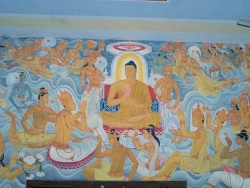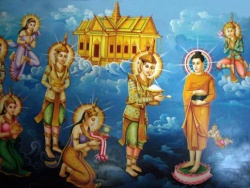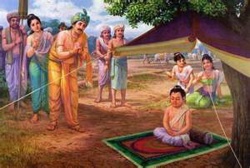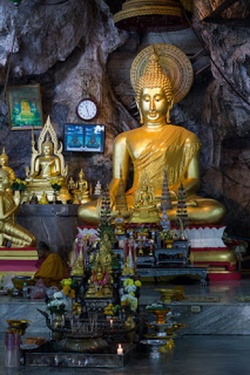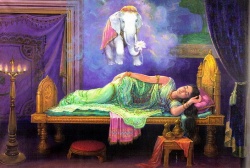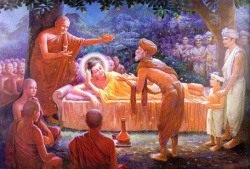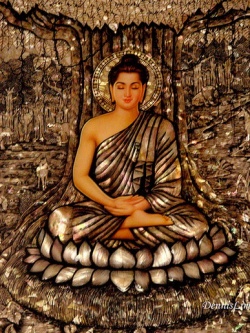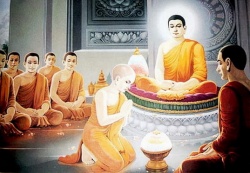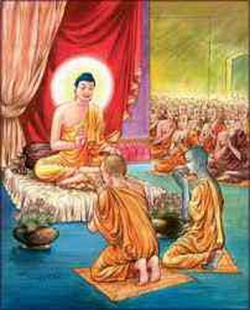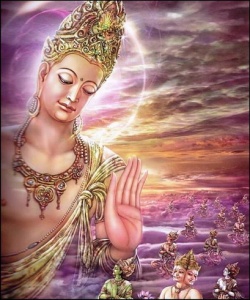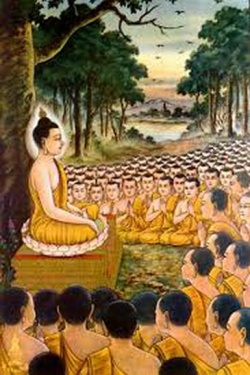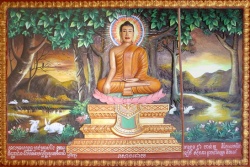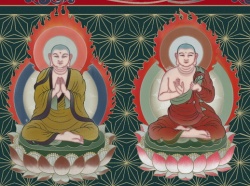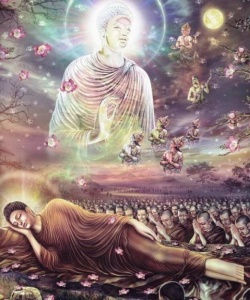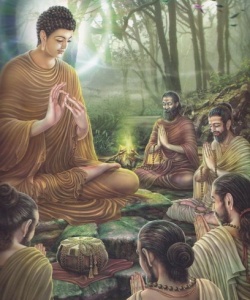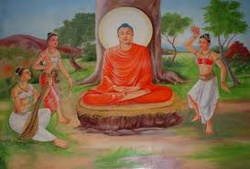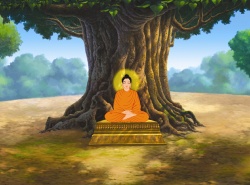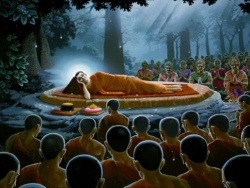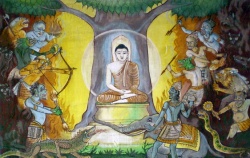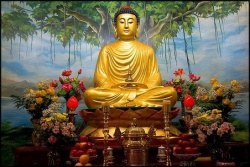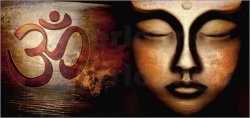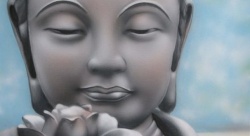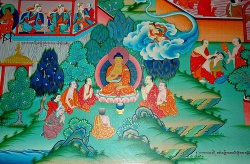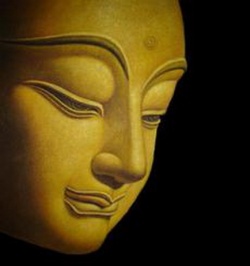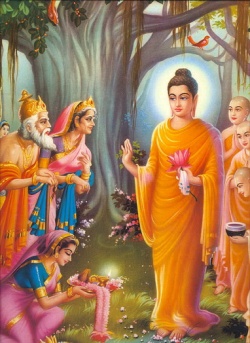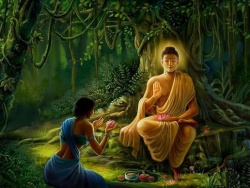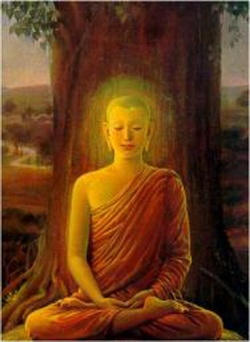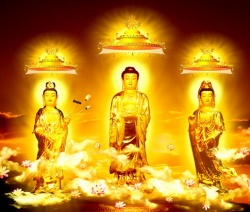Difference between revisions of "Manual Of Prajna Paramita"
(Created page with "BUDDHIST REFUGE Level 1of The Perfection of Wisdom (Prajna Paramita) Reading One: The Three Kinds of Refuge From the presentation on The Three Refuges found in the Analys...") |
|||
| (26 intermediate revisions by 5 users not shown) | |||
| Line 1: | Line 1: | ||
| − | + | [[File:100 1617.jpg|thumb|250px|]] | |
| − | |||
| − | |||
| − | |||
| − | + | <poem> | |
| + | [[BUDDHIST REFUGE]] | ||
| − | + | Level 1 of The [[Perfection of Wisdom]] ([[Prajna Paramita]]) | |
| − | |||
| − | |||
| − | + | Reading One: [[The Three Kinds of Refuge]] | |
| − | + | From the presentation on [[The Three Refuges]] found in the [[Analysis of the Perfection of Wisdom]], by [[Kedrup Tenpa Dargye]] (1493-1568): | |
| − | |||
| − | |||
| − | + | Here we will discuss the line of the [[root]] text which says, “The [[Three Jewels]], the [[Buddha]] and the rest.” Let us first consider the section of the middle-length [[sutra]] on the Mother which includes the lines: | |
| − | + | Do not think that this very [[Knowledge]] of All Things is something which applies to what you can see, and do not think it is separate from what you can see. Just so, never [[view]] what you can see itself as [[being]] real. | |
| − | This is the One, the Buddha: | + | These are the “Instruction on the [[Three Jewels]],” for they are words from the middle-length [[sutra]] on the Mother which give us the following advice: |
| + | [[File:000x297x1.jpg|thumb|250px|]] | ||
| + | These [[Three Jewels]] are no place of [[refuge]] for persons who seek an [[ultimate]] [[liberation]]. They are a place of [[refuge]] for persons who seek a [[liberation]] only in words. | ||
| + | |||
| + | |||
| + | Our analysis of this section will proceed in three parts: a refutation of our opponent’s position, a presentation of our [[own]] position, and a rebuttal of their objections. | ||
| + | |||
| + | Here is the second section, in which we {{Wiki|present}} our [[own]] position. There is a specific [[reason]] why the [[Three Jewels]] are established as [[being]] the [[refuges]] for practitioners of the [[three classes]]. From the point of [[view]] of [[cause]] [[refuge]], practitioners of all [[three classes]] take [[refuge]] in all three of the [[Jewels]]. But from the point of [[view]] of result [[refuge]], those of the Listener class aspire chiefly to attain the [[state]] of a [[foe destroyer]]. | ||
| + | |||
| + | Those of the class of Self-Made [[Buddhas]] aspire chiefly to attain that [[meditative]] [[wisdom]] where they abide in a [[meditation]] of [[cessation]], a [[state]] where all the [[obstacles]] of the [[mental]] [[afflictions]] have been eliminated. | ||
| + | |||
| + | |||
| + | Those of the Greater Way aspire chiefly to attain the [[Buddha]] [[Jewel]], one who possesses that [[cause]] within him which will allow him to turn the [[wheel]] of the [[dharma]], in its entirety, for [[disciples]] of all [[three classes]]. This then is the [[reason]] why the [[Three Jewels]] are established as [[being]] [[refuges]] for practitioners of the [[three classes]]. | ||
| + | |||
| + | |||
| + | |||
| + | The [[definition]] of the [[Buddha]] [[Jewel]] is “That [[ultimate]] place of [[refuge]], the one which has completely satisfied both the needs.” There are two kinds of [[Buddha]] [[Jewel]]: the apparent [[Buddha]] [[Jewel]], and the [[ultimate]] [[Buddha]] [[Jewel]]. | ||
| + | [[File:002asd.jpg|thumb|250px|]] | ||
| + | This [[Buddha]] [[Jewel]] posseses eight different fine qualities, beginning with the [[quality]] of [[being]] uncaused. As the Higher Line states, | ||
| + | |||
| + | |||
| + | This is the One, the [[Buddha]]: | ||
He is uncaused, He is spontaneous, | He is uncaused, He is spontaneous, | ||
| − | He is realized by no other way; | + | He is [[realized]] by no other way; |
| − | He has knowledge, and love, and power; | + | He has [[knowledge]], and [[love]], and power; |
He has satisfied both the needs. | He has satisfied both the needs. | ||
| − | |||
| − | |||
| − | The definition of an | + | The [[definition]] of the [[Dharma]] [[Jewel]] is “The [[enlightened]] side of {{Wiki|truth}}, either in the [[form]] of a [[cessation]], or in the [[form]] of a [[path]], or both.” In [[name]] only this [[Jewel]] can be divided into two kinds: the [[ultimate]] [[Dharma]] [[Jewel]], and the apparent [[Dharma]] [[Jewel]]. |
| + | [[File:00x2400.jpg|thumb|250px|]] | ||
| + | |||
| + | The [[definition]] of the [[Sangha]] [[Jewel]] is “A [[realized]] [[being]] who possesses any number of the eight fine qualities of [[knowledge]] and [[liberation]].” In [[name]] only, this [[Jewel]] can be divided into two kinds: the [[ultimate]] [[Sangha]] [[Jewel]], and the apparent [[Sangha]] [[Jewel]]. | ||
| + | |||
| + | |||
| + | The [[definition]] of an apparent [[refuge]] is “Any [[refuge]] where the journey along the [[path]] has not reached its final goal.” | ||
| + | |||
| + | The [[definition]] of [[taking refuge]] is “Any {{Wiki|movement}} of the [[mind]] that acts of its [[own]] accord, and consists of hoping that some [[object]] outside of one’s [[self]] will be [[able]] to render one assistance.” | ||
| + | |||
| + | In [[name]] only, [[taking refuge]] may be divided into two: [[taking refuge]] in words, the expression of [[refuge]]; and [[taking refuge]] in [[thoughts]], the reliance on [[refuge]]. An example of the first would be something like the words you use as you [[take refuge]]. | ||
| + | |||
| + | |||
| + | The [[latter]] is of two types: ordinary taking of [[refuge]], and [[exceptional]] taking of [[refuge]]. The [[definition]] of the first is “Any {{Wiki|movement}} of the [[mind]] which acts of its [[own]] accord, and consists of hoping that some ordinary type of [[refuge]] will render one assistance.” | ||
| + | |||
| + | |||
| + | |||
| + | The [[definition]] of the [[latter]] is “Any {{Wiki|movement}} of the [[mind]] which acts of its [[own]] accord, and consists of hoping that any one or number of the [[Three Jewels]] will render one assistance.” | ||
| + | [[File:0147.jpg|thumb|250px|]] | ||
| + | |||
| + | |||
| + | There are five different kinds of this [[extraordinary]] taking of [[refuge]]: the taking of [[refuge]] which is shared with practitioners of a lesser scope, the taking of [[refuge]] which is shared with practitioners of a {{Wiki|medium}} scope, the taking of [[refuge]] which is shared with practitioners of a greater scope, [[cause]] [[refuge]], and result [[refuge]]. | ||
| + | |||
| + | Here are their respective definitions. The first is defined as: “First, you [[feel]] a personal {{Wiki|fear}} for the [[sufferings]] of the [[births]] of [[misery]]. Second, you believe that the [[Three Jewels]] possess the [[power]] to {{Wiki|protect}} you from these [[sufferings]]. Finally, you have a [[thought]] which acts of its [[own]] accord: it is a {{Wiki|hope}}, or something of the type, that some one or number of the [[Three Jewels]] will render you assistance, to {{Wiki|protect}} you from these [[sufferings]]. | ||
| − | |||
| − | |||
| − | + | The second is defined as: “First, you [[feel]] a personal {{Wiki|fear}} for each and every [[suffering]] of the cycle of [[life]]. Second, you believe that the [[Three Jewels]] possess the [[power]] to {{Wiki|protect}} you from these [[sufferings]]. Finally you have a {{Wiki|movement}} of the [[mind]] which acts of its [[own]] accord: it is a {{Wiki|hope}}, or something of the type, that some one or number of the [[Three Jewels]] will render you assistance, to {{Wiki|protect}} you from these [[sufferings]]. | |
| − | The | + | The third is defined as: “Any {{Wiki|movement}} of the [[mind]] which acts of its [[own]] accord, and consists of hoping that any one or number of the [[Three Jewels]] will render assistance, to {{Wiki|protect}} every [[living being]] from the [[sufferings]] of the cycle of [[life]].” |
| − | |||
| − | + | The fourth is defined as: “Any {{Wiki|movement}} of the [[mind]] which acts of its [[own]] accord, and consists of hoping that any one or number of the [[Three Jewels]], as already achieved in another [[person]], will render assistance.” The fifth is defined as: “Any {{Wiki|movement}} of the [[mind]] which acts of its [[own]] accord, and consists of hoping that any one or number of the [[Three Jewels]], as they are to be achieved within ones [[self]], will render assistance.” | |
| + | [[File:01g.jpg|thumb|250px|]] | ||
| − | |||
| − | + | There is a specific {{Wiki|purpose}} for [[taking refuge]] in the [[Three Jewels]]. A {{Wiki|temporal}} {{Wiki|purpose}} is that they can provide you the [[highest]] [[form]] of [[protection]]. The [[ultimate]] {{Wiki|purpose}} is to attain the [[state of enlightenment]]. | |
| − | + | Taking [[refuge]] also serves as the foundation for all the different kinds of [[vows]]. When you take [[refuge]], you thereby join the ranks of the “ones inside”: you become a [[Buddhist]]. This [[taking refuge]] acts as well to slam shut the door to the [[births]] of [[misery]]. These and others are the {{Wiki|purpose}} for [[taking refuge]] in the Three. | |
| − | |||
| − | |||
| − | + | ==Reading Two: The Wish for [[Enlightenment]]== | |
| − | + | From the presentation on The Wish for [[Enlightenment]] found in the Overview of the [[Perfection of Wisdom]], by [[Kedrup Tenpa Dargye]] (1493-1568): | |
| − | + | Here we will discuss the lines of the [[root]] text which begin with “The wish for [[enlightenment]] is, for the [[benefit]] of others…” First we will relate this {{Wiki|concept}} to the original texts, and then we will analyze it in detail. | |
| − | Here | + | Here is the first. We find the following lines in [[sutra]]: |
| + | [[File:01jpegn.jpeg|thumb|250px|]] | ||
| + | Sharibu, those who wish to gain total [[enlightenment]], a [[knowledge]] of every kind of thing, must train themselves in the [[perfection of wisdom]]. Those who wish this, and that, must train themselves in the [[wisdom]] [[perfection]]. | ||
| − | + | The [[root]] text and commentary include other lines that begin with “The wish for [[enlightenment]] is” and continue up to “the twenty-two.” The [[function]] of these [[latter]] [[sections]] is to clarify the hidden meaning of the words of the [[sutra]], [[including]] as it does the [[essential]] [[nature]] of the wish for [[enlightenment]]. | |
| − | + | As such, we can understand the [[definition]] of the wish for [[enlightenment]] as “The wish to achieve total [[enlightenment]] for the [[benefit]] of others.” | |
| − | + | Here is the section in which we {{Wiki|present}} our [[own]] position. The [[definition]] of the greater way’s wish for [[enlightenment]] is as follows. | |
| − | + | First, it is that main [[mental]] [[awareness]] belonging to the greater way, which is focused on achieving total [[enlightenment]] for the [[benefit]] of others, and which is matched with a [[state of mind]] that is associated with it: the [[aspiration]] to achieve total [[enlightenment]]. | |
| − | + | Secondly, it is a [[knowledge]] belonging to the greater way, which acts as a door for entering the greater way (or is something of the type), and which is included into the [[activity]] side of the standard [[division]] into the two of “[[view]]” and “[[activity]].” | |
| + | [[File:038f9e01a.jpg|thumb|250px|]] | ||
| + | Here next are the divisions of this wish. Nominally, the wish can be divided into the apparent wish for [[enlightenment]] and the [[ultimate]] wish for [[enlightenment]]. In [[essence]], it can be divided into the wish of [[prayer]] and the wish of engagement. In terms of level, it can be divided into the four types that begin with “the wish that acts out of [[belief]].” In terms of how the wish is developed, there are three types, starting with the “king’s wish.” | ||
| − | |||
| − | |||
| − | + | ==Reading Three: What is [[Nirvana]]?== | |
| + | From the presentation on [[Nirvana]] found in the Analysis of the [[Perfection of Wisdom]], by [[Kedrup Tenpa Dargye]] (1493-1568): | ||
| − | + | Here secondly is the section in which we {{Wiki|present}} our [[own]] position. The [[definition]] of [[nirvana]] is “A [[cessation]] which comes from the {{Wiki|individual}} analysis, and which consists of having eliminated the mental-affliction [[obstacles]] in their entirety.” | |
| − | + | In [[name]] only, [[nirvana]] can be divided into the following four types: natural [[nirvana]], [[nirvana]] with something left over, [[nirvana]] with [[nothing]] left over, and [[nirvana]] which does not stay. | |
| + | [[File:04351.jpg|thumb|250px|]] | ||
| − | + | The following all refer to the same thing: natural [[nirvana]], the natural Mother, the natural [[perfection of wisdom]], the natural [[Dharma Body]], and [[ultimate truth]]. The [[definition]] of [[nirvana]] with something left over is: “A [[cessation]] which comes from the {{Wiki|individual}} analysis, and which consists of having eliminated the mental-affliction [[obstacles]] in their entirety, but where one still has the [[suffering]] heaps that are a result of his {{Wiki|past}} [[actions]] and bad [[thoughts]].” A classical example of this would | |
| − | + | be the [[nirvana]] found in the [[mental]] {{Wiki|stream}} of a listener who is a [[foe destroyer]], and who has not yet shucked off the heaps he took on. The [[definition]] of [[nirvana]] with [[nothing]] left over is: “A [[cessation]] which comes from the {{Wiki|individual}} analysis, and which consists of having eliminated the mental-affliction [[obstacles]] in their entirety, and where one is free of the [[suffering]] heaps that are a result of his {{Wiki|past}} [[actions]] and bad [[thoughts]].” A classical example of this would be the [[nirvana]] found in the [[mental]] {{Wiki|stream}} of a listener who is a [[foe destroyer]], and who has shucked off the heaps he took on. | |
| − | |||
| − | The definition of nirvana which does not stay is: “A cessation which comes from the individual analysis, and which consists of having eliminated both kinds of obstacles in their entirety.” A classical example of this would be the truth of cessation in the mental stream of a realized being who is a Buddha. The nirvana we are describing here is | + | The [[definition]] of [[nirvana]] which does not stay is: “A [[cessation]] which comes from the {{Wiki|individual}} analysis, and which consists of having eliminated both kinds of [[obstacles]] in their entirety.” A classical example of this would be the [[truth]] of [[cessation]] in the [[mental]] {{Wiki|stream}} of a [[realized]] [[being]] who is a [[Buddha]]. The [[nirvana]] we are describing here is |
| − | + | not something that one can achieve by using any method at all. Rather, you must achieve it with the {{Wiki|training}} of [[wisdom]], which realizes that [[nothing]] has any [[self]] [[nature]]; this [[wisdom]] must be under the [[influence]] of the first two trainings, and with it you must [[habituate]] yourself to what you were already [[able]] to realize. | |
| − | |||
| − | + | This fact is supported by the [[King]] of [[Concentration]]h states: | |
| − | And after that you habituate | + | |
| + | |||
| + | Suppose you are [[able]] to analyze | ||
| + | [[File:10854 n.jpg|thumb|250px|]] | ||
| + | One by one those things that have [[no self]]; | ||
| + | |||
| + | And after that you [[habituate]] | ||
Yourself to what you analyzed individually. | Yourself to what you analyzed individually. | ||
| Line 121: | Line 160: | ||
This is what then leads you to | This is what then leads you to | ||
| − | Achieve your freedom; nirvana beyond grief. | + | Achieve your freedom; [[nirvana]] beyond [[grief]]. |
It is impossible for any other | It is impossible for any other | ||
| − | Cause to bring this peace to you. | + | [[Cause]] to bring this [[peace]] to you. |
| + | |||
| + | Reading Four: The [[Object]] We Deny | ||
| + | |||
| + | [[File:10d2fd63.jpg|thumb|250px|]] | ||
| + | From the presentation on The [[Object]] We Deny found in the Overview of the [[Perfection of Wisdom]], by [[Kedrup Tenpa Dargye]] (1493-1568): | ||
| + | |||
| − | |||
| − | + | Next we will explain what it means when we say that the three of basic [[knowledge]], [[path]] [[knowledge]], and the [[knowledge]] of all things have no {{Wiki|real}} [[nature]] of [[arising]]. This explanation has three parts: identifying what it is we deny with {{Wiki|reasoning}} that treats the [[ultimate]]; introducing the various [[reasons]] used to deny this [[object]]; and, once we have established these two, detailing the steps to develop [[correct view]]. | |
| + | The first of these has two [[sections]] of its [[own]]: a demonstration of why we must identify what it is we deny, and then the actual identification of this [[object]]. Before a [[person]] can develop within his [[mind]] that correct [[view]] which realizes [[emptiness]], he must first identify the final [[object]] which is denied with {{Wiki|reasoning}} that treats the [[ultimate]]. As the [[Guide]] to the [[Bodhisattva’s]] Way of [[Life]] states, | ||
| + | Until you can find what you [[thought]] was there, | ||
| − | + | You can never [[grasp]] how it cannot [[exist]]. | |
| + | [[File:111.jpg|thumb|250px|]] | ||
| − | + | Suppose that what you sought to deny was the [[existence]] of a [[water]] pitcher in a certain place. If before you started you had no [[mental]] picture of what a [[water]] pitcher looked like, you would never be [[able]] to verify with an accurate [[perception]] that it wasn’t there. Here it’s just the same. What we seek to deny is that things could really [[exist]]. If before we start we have no [[mental]] picture of what a thing that really [[exists]] would be like, then we can never have a clear [[idea]] of [[emptiness]]: the simple absence where the [[object]] that we deny isn’t there. | |
| − | |||
| − | + | Here now is the actual identification of the [[object]] we deny. Suppose something were to occur in some way that was opposite to the way that all the [[phenomena]] of [[physical]] [[form]] and so on [[exist]] deceptively. Anything that could occur this way would be precisely the final [[object]] we deny with {{Wiki|reasoning}} that treats the [[ultimate]]. Therefore we must first explain how it is that all the [[phenomena]] of [[physical]] [[form]] and the rest [[exist]] deceptively. | |
| − | + | The second part to the [[discussion]] of how things [[exist]] deceptively consists of an explanation of the various [[scriptural]] references. First we will give a brief treatment of these references, and after that talk about how this system establishes the [[two truths]]; this [[latter]] step will include an instructive {{Wiki|metaphor}}. Here now is the briefer treatment. | |
| − | |||
| − | + | There is a specific [[reason]] why we say that all these [[phenomena]], [[physical]] [[form]] and the rest, [[exist]] deceptively. They are described this way because their [[existence]] is established by means of a deceptive [[state of mind]], one which is not affected by a temporary factor that would [[cause]] it to be mistaken. | |
| + | [[File:13sd.jpg|thumb|250px|]] | ||
| + | That [[state of mind]] which acts to establish the [[existence]] of [[physical]] [[form]] and other such things, and which is colored by [[seeing]] things as [[being]] {{Wiki|real}}, and which is not affected by a temporary factor that would [[cause]] it to be mistaken, is only the deceptive [[mind]]. This deceptive [[state of mind]] though is not the actual [[grasping]] to {{Wiki|real}} [[existence]], for it holds its [[object]] in a way which is consistent with what the [[object]] actually is. The [[state of mind]] is deceptive in that the deceptive [[mind]] is affected by the tendency to [[grasp]] to things as [[being]] real. | ||
| − | + | Therefore any and every [[object]] whose [[existence]] is established by a consistent [[state of mind]] belonging to a [[living being]] who is not a [[Buddha]] is said to [[exist]] “deceptively.” The deceptive [[state of mind]] occurs by force of a deep [[mental]] seed which [[causes]] it to be mistaken; this is a seed for the tendency to [[grasp]] to things as [[being]] {{Wiki|real}}, and it has been in our [[minds]] for [[time]] without beginning. This seed makes every living creature who is not a [[Buddha]] see every [[existing]] | |
| − | + | [[phenomenon]], [[physical]] [[form]] and the rest, look as if it were a [[pure]], discrete [[entity]]. And so we call a [[state of mind]] “deceptive” when it holds that [[physical]] [[form]] and all other things purely [[exist]], whereas in fact they are quite the opposite: they do not purely [[exist]]. We say it is “deceptive” ([[Sanskrit]]: sawˆ vr¸ti] because such a [[state of mind]] is itself [[blind]] to [[the way things really are]], and also because it functions in a [[sense]] to screen ([[Sanskrit]]: vr¸] or cover other things; it keeps us from [[seeing]] their [[suchness]]. | |
| − | + | So now we can define the final [[object]] which we deny by {{Wiki|reasoning}} that treats the [[ultimate]]. It is any [[object]] of the [[mind]] that could [[exist]] on its side through its [[own]] unique way of being, without its [[existence]] having to be established by the fact of its appearing to a [[state of mind]] that is not impaired. This is true | |
| + | [[File:143kl.jpg|thumb|250px|]] | ||
| − | + | because the final way in which [[physical]] [[form]] and all other such [[phenomena]] [[exist]] deceptively is that they are established as [[existing]] by force of a [[state of mind]] which is not impaired by any temporary factor that would [[cause]] it to be mistaken. | |
| − | + | There is an instructive {{Wiki|metaphor}} we can use for describing how [[physical]] [[form]] and other such [[phenomena]] are from our side established as [[existing]], by the fact of their appearing to a [[state of mind]] which is not impaired; while at the same [[time]] these [[objects]] of our [[mind]] [[exist]] on their [[own]] side through their [[own]] way of being. | |
| − | + | Suppose a [[Wikipedia:Magician(paranormal)|magician]] is making a little piece of [[wood]] appear as a [[horse]] or {{Wiki|cow}}. [[Seeing]] the piece of [[wood]] as a [[horse]] or {{Wiki|cow}} comes from the side of the viewer, by the force of his [[own]] [[mind]], as his [[eyes]] are affected by the spell of the [[Wikipedia:Magician(paranormal)|magician]]. And yet the piece of [[wood]], from its side, is appearing this way as well. Both [[conditions]] must be {{Wiki|present}}. | |
| − | |||
| − | There is a reason why the first condition must be present: the condition of being established from the side of the viewer, by force of his own mind, as his eyes are affected by the spell of the magician. If this condition didn’t have to be present, then a spectator whose eyes were not affected by the spell would have to see the wood appear as the animal, whereas in actuality he does not. | + | There is a [[reason]] why the first [[condition]] must be {{Wiki|present}}: the [[condition]] of [[being]] established from the side of the viewer, by force of his [[own]] [[mind]], as his [[eyes]] are affected by the spell of the [[Wikipedia:Magician(paranormal)|magician]]. If this [[condition]] didn’t have to be {{Wiki|present}}, then a spectator whose [[eyes]] were not affected by the spell would have to see the [[wood]] appear as the [[animal]], whereas in [[actuality]] he does not. |
| − | At this same time the second condition, that the piece of wood appear from its own side as a horse or cow, must be present as well. If this condition didn’t have to be present, then the piece of wood’s appearing as a horse or cow would have to show up as well in places where there were no piece of wood, whereas in actuality it does not. | + | At this same [[time]] the second [[condition]], that the piece of [[wood]] appear from its [[own]] side as a [[horse]] or {{Wiki|cow}}, must be {{Wiki|present}} as well. If this [[condition]] didn’t have to be {{Wiki|present}}, then the piece of wood’s appearing as a [[horse]] or {{Wiki|cow}} would have to show up as well in places where there were no piece of [[wood]], whereas in [[actuality]] it does not. |
| + | [[File:145x.jpg|thumb|250px|]] | ||
| + | In this same way are the [[phenomena]] of [[physical]] [[form]] and the rest established by force of a [[state of mind]] which is not impaired. They are labeled with names, through an unimpaired [[state of mind]] and a [[name]] which is consistent with what they are. | ||
| − | + | They do not however [[exist]] on their side through their [[own]] unique way of being, without their [[existence]] having to be established by the fact of their appearing to a [[state of mind]] that is not impaired. If they were to [[exist]] this way, then they would have to be the [[ultimate]] way things are. And if they were, then they would have to be [[realized]] directly by a [[state of mind]] which was not mistaken; by the [[wisdom]] of a [[realized]] [[being]] who is not a [[Buddha]], and who in a [[state]] of balanced [[meditation]] is directly [[realizing]] the way things are. In fact though they are not directly [[realized]] by such a [[wisdom]]. | |
| − | |||
| − | Suppose a magician makes a little piece of wood appear as a horse or cow. Spectators whose eyes have been affected by his spell both see the piece of wood as a horse or cow and believe that it really is. The magician himself only sees the horse or cow; he has no belief that it is real. A spectator who arrives later, who hasn’t had the spell cast on him, neither sees the piece of wood as a horse or cow nor believes that it is. | + | Suppose a [[Wikipedia:Magician(paranormal)|magician]] makes a little piece of [[wood]] appear as a [[horse]] or {{Wiki|cow}}. Spectators whose [[eyes]] have been affected by his spell both see the piece of [[wood]] as a [[horse]] or {{Wiki|cow}} and believe that it really is. The [[Wikipedia:Magician(paranormal)|magician]] himself only sees the [[horse]] or {{Wiki|cow}}; he has no [[belief]] that it is {{Wiki|real}}. A spectator who arrives later, who hasn’t had the spell cast on him, neither sees the piece of [[wood]] as a [[horse]] or {{Wiki|cow}} nor believes that it is. |
| − | Three different combinations of seeing and believing exist as well with physical form and other such phenomena. The kind of people we call “common” people, those who have never had a realization of emptiness, both see and believe that form and the rest really exist. Bodhisattvas who are at one of the pure levels see phenomena as really existing during the periods following emptiness meditation; but they do not believe it. Realized beings who are not yet Buddhas, and who are in the state where they are realizing the way things are directly, neither see physical form and other such phenomena as really existing, nor do they believe that they really exist. | + | Three different combinations of [[seeing]] and believing [[exist]] as well with [[physical]] [[form]] and other such [[phenomena]]. The kind of [[people]] we call “common” [[people]], those who have never had a [[realization]] of [[emptiness]], both see and believe that [[form]] and the rest really [[exist]]. [[Bodhisattvas]] who are at one of the [[pure]] levels see [[phenomena]] as really [[existing]] during the periods following [[emptiness]] [[meditation]]; but they do not believe it. [[Realized]] [[beings]] who are not yet [[Buddhas]], and who are in the [[state]] where they are [[realizing]] the way things are directly, neither see [[physical]] [[form]] and other such [[phenomena]] as really [[existing]], nor do they believe that they really [[exist]]. |
| + | [[File:147ages.jpg|thumb|250px|]] | ||
| − | The Implication and Independent branches of the Middle Way school are identical in asserting that to exist really, to exist purely, to exist just so, to exist ultimately, and the idea where you hold that things could exist these ways are all objects which are denied by reasoning that treats the ultimate. | + | The Implication and Independent branches of the [[Middle Way]] school are [[identical]] in asserting that to [[exist]] really, to [[exist]] purely, to [[exist]] just so, to [[exist]] ultimately, and the [[idea]] where you hold that things could [[exist]] these ways are all [[objects]] which are denied by {{Wiki|reasoning}} that treats the [[Wikipedia:Absolute (philosophy)|ultimate]]. |
| − | The Independent branch though does not agree that to exist from its own side, to exist by nature, to exist in substance, to exist by definition, and the idea where you hold that form and other such phenomena could exist | + | The Independent branch though does not agree that to [[exist]] from its [[own]] side, to [[exist]] by [[nature]], to [[exist]] in [[substance]], to [[exist]] by [[definition]], and the [[idea]] where you hold that [[form]] and other such [[phenomena]] could [[exist]] |
| − | + | these ways are also [[objects]] which are denied by {{Wiki|reasoning}} that treats the [[ultimate]]. They say that in fact anything that [[exists]] must [[exist]] these ways, with the exception of [[existing]] in [[substance]]. (There is some question though about things that are nominal.) They assert that any functional thing that [[exists]] must [[exist]] in [[substance]]. | |
| + | Neither the Implication nor the Independent branches of the [[Middle Way]] school asserts that to [[exist]] as the way things are, to [[exist]] as [[ultimate truth]], or to [[exist]] as the {{Wiki|real}} [[nature]] of things is the final [[object]] which is denied by {{Wiki|reasoning}} that treats the [[ultimate]]; for if something is [[ultimate truth]], it always [[exists]] in all these [[three ways]]. | ||
| − | |||
| − | + | Reading Five: The Proofs for [[Emptiness]] | |
| − | Here secondly is our own position. | + | From the presentation on The Proofs for [[Emptiness]] ["The [[Emptiness]] of One or Many"] found in the Analysis of the [[Perfection of Wisdom]], by [[Kedrup Tenpa Dargye]] (1493-1568): |
| + | [[File:19gmkm.jpg|thumb|250px|]] | ||
| + | Here secondly is our [[own]] position. | ||
| − | |||
| − | + | Consider the three: basic [[knowledge]], [[path]] [[knowledge]], and the [[knowledge]] of all things. | |
| − | + | They do not really [[exist]]; | |
| − | + | For they [[exist]] neither as one thing which really [[exists]], nor as many things which really [[exist]]. | |
| − | + | They are, for example, like the {{Wiki|reflection}} of a figure in a [[mirror]]. | |
| − | The | + | The [[Jewel]] of the [[Middle Way]] supports this when it says, |
| − | Are free of being purely one | + | The things of [[self]] and other |
| + | [[File:211120.jpg|thumb|250px|]] | ||
| + | Are free of [[being]] purely one | ||
| − | Or being purely many, | + | Or [[being]] purely many, |
| − | And so they have no nature: | + | And so they have no [[nature]]: |
| − | Just like a reflection. | + | Just like a {{Wiki|reflection}}. |
Consider these same things. | Consider these same things. | ||
| − | They do not exist as one thing which really exists; | + | They do not [[exist]] as one thing which really [[exists]]; |
For they are things with parts. | For they are things with parts. | ||
| − | The one always implies the other, for if something existed as one thing which really exists, then it could never be a thing which appeared one way but actually existed in a different way. | + | The one always implies the other, for if something existed as one thing which really [[exists]], then it could never be a thing which appeared one way but actually existed in a different way. |
| − | + | [[File:217106.jpg|thumb|250px|]] | |
| − | They do not exist as many things which really exist, because they do not exist as one thing which really exists. The one always implies the other, for many things come from bringing together a group of things that are one. | + | They do not [[exist]] as many things which really [[exist]], because they do not [[exist]] as one thing which really [[exists]]. The one always implies the other, for many things come from bringing together a group of things that are one. |
| − | The implication in the original statement is true, for if something really existed, it would have to exist either as one thing that really existed or as many things that really existed. This is always the case, for if something exists it must exist either as one or as many. | + | The implication in the original statement is true, for if something really existed, it would have to [[exist]] either as one thing that really existed or as many things that really existed. This is always the case, for if something [[exists]] it must [[exist]] either as one or as many. |
| − | Here is the “Sliver of | + | Here is the “Sliver of [[Diamond]]” {{Wiki|reasoning}}, for denying that things can come from [[causes]]: |
| − | Consider all inner and outer things that perform a function. They do not arise ultimately, For they do not arise from themselves, and they do not arise ultimately from something other than themselves, and they do not arise from both, and they do not arise without a cause. | + | Consider all inner and outer things that perform a [[function]]. They do not arise ultimately, For they do not arise from themselves, and they do not arise ultimately from something other than themselves, and they do not arise from both, and they do not arise without a [[cause]]. |
| − | These things do not arise from themselves, because they do not arise from a cause which is such that, if something were the cause, it would have to be the thing it caused. | + | These things do not arise from themselves, because they do not arise from a [[cause]] which is such that, if something were the [[cause]], it would have to be the thing it [[caused]]. |
| − | They do not arise ultimately from something which is other than themselves, for they neither arise ultimately from a cause which is other than themselves and which is unchanging, nor do they arise ultimately from a cause which is other from themselves and which is changing. | + | They do not arise ultimately from something which is other than themselves, for they neither arise ultimately from a [[cause]] which is other than themselves and which is [[unchanging]], nor do they arise ultimately from a [[cause]] which is other from themselves and which is changing. |
| + | [[File:220d36.jpg|thumb|250px|]] | ||
They do not arise ultimately from both the above, because they do not arise ultimately from either one of them individually. | They do not arise ultimately from both the above, because they do not arise ultimately from either one of them individually. | ||
| − | They do not arise without a cause, because that would be utterly absurd. The implication in the original statement is true, for if something were to arise ultimately, it would have to arise ultimately through one of the four possibilities mentioned. | + | They do not arise without a [[cause]], because that would be utterly absurd. The implication in the original statement is true, for if something were to arise ultimately, it would have to arise ultimately through one of the four possibilities mentioned. |
| − | Here is the reasoning called “The Denial that Things which Exist or Do Not Exist could Arise,” which we use for denying that things can come from results: | + | Here is the {{Wiki|reasoning}} called “The Denial that Things which [[Exist]] or Do Not [[Exist]] could Arise,” which we use for denying that things can come from results: |
| − | Consider results. They do not arise ultimately, For results which exist at the time of their cause do not arise ultimately, and results that do not exist at the time of their cause do not arise ultimately, and results that both exist and do not exist at the time of their cause do not arise ultimately, and results that neither exist nor do not exist at the time of their cause do not arise ultimately. | + | Consider results. They do not arise ultimately, For results which [[exist]] at the [[time]] of their [[cause]] do not arise ultimately, and results that do not [[exist]] at the [[time]] of their [[cause]] do not arise ultimately, and results that both [[exist]] and do not [[exist]] at the [[time]] of their [[cause]] do not arise ultimately, and results that neither [[exist]] nor do not [[exist]] at the [[time]] of their [[cause]] do not arise ultimately. |
The implication is proven in the same way as above. | The implication is proven in the same way as above. | ||
| − | Here is the reasoning known as “The Denial that Things could Arise through Any of the Four Possibilities,” which we use for denying that things can come from both causes and results: | + | Here is the {{Wiki|reasoning}} known as “The Denial that Things could Arise through Any of the Four Possibilities,” which we use for denying that things can come from both [[causes]] and results: |
| + | [[File:221.jpg|thumb|250px|]] | ||
| − | Consider the functional things of causes and results. They do not arise ultimately, For multiple results of multiple causes do not arise ultimately, and single results of multiple causes do not arise ultimately, and multiple results of single causes do not arise ultimately, and single results of single causes do not arise ultimately. | + | Consider the functional things of [[causes]] and results. They do not arise ultimately, For multiple results of multiple [[causes]] do not arise ultimately, and single results of multiple [[causes]] do not arise ultimately, and multiple results of single [[causes]] do not arise ultimately, and single results of single [[causes]] do not arise ultimately. |
| − | [From the Overview:] Here we will explain the fifth type of reasoning, the one based on interdependence, and known as the | + | [From the Overview:] Here we will explain the fifth type of {{Wiki|reasoning}}, the one based on [[interdependence]], and known as the “[[King]] of [[Reasons]].” First we will {{Wiki|present}} the {{Wiki|reasoning}}, and then secondly prove the validity of its [[elements]]. |
| − | Consider all inner and outer things that perform a function. | + | Consider all inner and outer things that perform a [[function]]. |
| − | They are not real, For they are interdependent. The reasoning can also be stated as: | + | They are not {{Wiki|real}}, For they are [[interdependent]]. The {{Wiki|reasoning}} can also be stated as: |
| − | Consider all inner and outer things that perform a function. They do not arise really, For they arise in dependence on other things which act as their causes and conditions. | + | Consider all inner and outer things that perform a [[function]]. They do not arise really, For they arise in [[dependence]] on other things which act as their [[causes]] and [[conditions]]. |
| − | Either way you state the reasoning, the following part should be added at the end: They are, for example, like the reflection of a figure in a mirror. This reasoning is correct, for it is spoken by the Protector [Nagarjuna]: | + | Either way you [[state]] the {{Wiki|reasoning}}, the following part should be added at the end: They are, for example, like the {{Wiki|reflection}} of a figure in a [[mirror]]. This {{Wiki|reasoning}} is correct, for it is spoken by the [[Protector]] ([[Nagarjuna]]): |
| + | [[File:2as.jpg|thumb|250px|]] | ||
| + | Anything that occurs in [[interdependence]] | ||
| − | + | Is also [[peace]] in its very [[essence]]. | |
| − | + | It is also proven by the [[Sutra]] Requested by [[Anavatapta]], which states: | |
| − | |||
| − | It is also proven by the Sutra Requested by Anavatapta, which states: | ||
Anything that arises from other factors | Anything that arises from other factors | ||
| Line 261: | Line 315: | ||
Does not arise; | Does not arise; | ||
| − | It has no nature of arising in this way. | + | It has no [[nature]] of [[arising]] in this way. |
I teach that anything which relies | I teach that anything which relies | ||
On any other factor | On any other factor | ||
| + | [[File:30ds.jpg|thumb|250px|]] | ||
| + | Is [[empty]]. | ||
| − | + | He who [[understands]] [[emptiness]] | |
| − | |||
| − | He who understands emptiness | ||
Acts rightly. | Acts rightly. | ||
| − | Now we will prove the various elements of this reasoning. This consists of two steps: proving the relationship between the subject and the reason, and proving the relationship between the reason and the characteristic asserted. Here is the first: | + | Now we will prove the various [[elements]] of this {{Wiki|reasoning}}. This consists of two steps: proving the relationship between the [[subject]] and the [[reason]], and proving the relationship between the [[reason]] and the [[characteristic]] asserted. Here is the first: |
| − | Consider all inner and outer things that perform a function. They are interdependent, For they consist of a label applied to their parts; they exist in dependence on their parts. | + | Consider all inner and outer things that perform a [[function]]. They are [[interdependent]], For they consist of a label applied to their parts; they [[exist]] in [[dependence]] on their parts. |
| − | The relationship between the reason and the characteristic asserted is proved as follows: | + | The relationship between the [[reason]] and the [[characteristic]] asserted is proved as follows: |
| − | If something either consists of a label applied to its parts, or exists in dependence on its parts, then it cannot be real; | + | If something either consists of a label applied to its parts, or [[exists]] in [[dependence]] on its parts, then it cannot be real; |
| − | For if something were real, neither of these two could apply to it. | + | For if something were {{Wiki|real}}, neither of these two could apply to it. |
| − | This is true because, if something were real, it would have to exist without relying on anything else. | + | This is true because, if something were {{Wiki|real}}, it would have to [[exist]] without relying on anything else. |
| + | [[File:33015 n.jpg|thumb|250px|]] | ||
| + | Proving the relationship between the [[subject]] and the [[reason]] in the [[latter]] version of the {{Wiki|reasoning}} is simple. This is how we prove the relationship between the [[subject]] and the [[characteristic]] asserted in this same version: | ||
| − | + | If something arises in [[dependence]] on other things which act as its [[causes]] and [[conditions]], it cannot arise really, | |
| − | |||
| − | If something arises in dependence on other things which act as its causes and conditions, it cannot arise really, | ||
For if something were to arise really, it would have to arise without relying on anything else. | For if something were to arise really, it would have to arise without relying on anything else. | ||
| − | Both versions of the reasoning represent a type of logic where the presence of something which cannot coexist with something else is used to prove that inner and outer things which perform a function either do not exist really or do not have any nature of arising really. This is true because both of the reasons stated are such that they cannnot coexist with existing really. | + | Both versions of the {{Wiki|reasoning}} represent a type of [[logic]] where the presence of something which cannot coexist with something else is used to prove that inner and outer things which perform a [[function]] either do not [[exist]] really or do not have any [[nature]] of [[arising]] really. This is true because both of the [[reasons]] stated are such that they cannnot coexist with [[existing]] really. |
| − | |||
| − | |||
| − | |||
| − | |||
| − | |||
| − | |||
| − | + | There is a specific [[reason]] why we refer to this {{Wiki|reasoning}}, the one based on [[interdependence]], as the “[[King]] of [[Reasons]].” First of all, each of the other reasonings here ultimately comes down to the {{Wiki|reasoning}} of [[interdependence]]. Secondly, this {{Wiki|reasoning}} allows one to eliminate, in one step, both the extreme of [[permanence]] and the extreme of ending focussed towards this particular [[subject]] or basis of dispute. | |
| + | Reading Six: Who is [[Maitreya]]? | ||
| + | From the presentation on The Text of [[Maitreya]] found in the Overview of the [[Perfection of Wisdom]], by [[Kedrup Tenpa Dargye]] (1493-1568): | ||
| − | Here is how these others make their argument. They say that “It is incorrect to relate the opening lines [of the Jewel of Realizations], the ones that are an offering of praise, to any need of the author himself. This is because Maitreya possesses no state of mind where he is aspiring to fulfill his own needs, and because the lines appear here only as a means to induce persons other than the author to follow the work.” | + | [[File:338a48773.jpg|thumb|250px|]] |
| + | Here is how these others make their argument. They say that “It is incorrect to relate the opening lines [of the [[Jewel]] of Realizations], the ones that are an [[offering]] of praise, to any need of the author himself. This is because [[Maitreya]] possesses no [[state of mind]] where he is aspiring to fulfill his [[own]] needs, and because the lines appear here only as a means to induce persons other than the author to follow the work.” | ||
| − | Here secondly is our own position. It is incorrect to make the argument that appeared earlier, for such an argument only reveals that the person making it has failed to undertake exhaustive study and contemplation of the major scriptures of the greater way. How can we say this? Let us first ask the following: do you make this argument assuming that the Holy One [Maitreya] is a Buddha, or do you make it assuming that he is a bodhisattva? | + | Here secondly is our [[own]] position. It is incorrect to make the argument that appeared earlier, for such an argument only reveals that the [[person]] making it has failed to undertake exhaustive study and [[contemplation]] of the major [[scriptures]] of the greater way. How can we say this? Let us first ask the following: do you make this argument assuming that the [[Holy One]] ([[Maitreya]]) is a [[Buddha]], or do you make it assuming that he is a [[bodhisattva]]? |
| − | Suppose you say that you are making the former assumption. Doing so represents a failure to distinguish between speaking in the context of the way which is shared, the way of the perfections, and speaking in the context of the way which is not shared; that is, the way of the secret word. | + | Suppose you say that you are making the former assumption. [[Doing]] so represents a failure to distinguish between {{Wiki|speaking}} in the context of the way which is shared, the way of the [[perfections]], and {{Wiki|speaking}} in the context of the way which is not shared; that is, the way of the secret [[word]]. |
| − | The teaching of the secret way says that the holy Maitreya is a Buddha. This is true because—according to the secret way—Manjushri is a Buddha, and the reasons for His being so apply equally to Maitreya in every respect. | + | The [[teaching]] of the secret way says that the {{Wiki|holy}} [[Maitreya]] is a [[Buddha]]. This is true because—according to the secret way—Manjushri is a [[Buddha]], and the [[reasons]] for His [[being]] so apply equally to [[Maitreya]] in every [[respect]]. |
| − | It is correct for us to say that the way of the perfections is the way which is “shared,” and that the way of the secret word is the way which is “not shared.” This is because such a description is found in a great number of authoritative works. The Steps of the Path to Buddhahood, for example, speaks about “how to train oneself in the way which is shared—the way of the perfections, and how to train oneself in the way which is not shared—the way of the secret word.” The Concise Steps as well includes the lines: | + | It is correct for us to say that the way of the [[perfections]] is the way which is “shared,” and that the way of the secret [[word]] is the way which is “not shared.” This is because such a description is found in a great number of authoritative works. The Steps of the [[Path]] to [[Buddhahood]], for example, speaks about “how to train oneself in the way which is shared—the way of the [[perfections]], and how to train oneself in the way which is not shared—the way of the secret [[word]].” The Concise Steps as well includes the lines: |
| − | |||
| − | |||
| + | Thus is the [[path]] which is shared, | ||
| + | [[File:36.jpg|thumb|250px|]] | ||
The one which is required | The one which is required | ||
| − | At both the stage of the cause | + | At both the stage of the [[cause]] |
As well as the stage of result | As well as the stage of result | ||
| Line 323: | Line 374: | ||
In the higher way, | In the higher way, | ||
| − | The path which is supreme. | + | The [[path]] which is supreme. |
| − | There is another description that mentions the “way for common | + | There is another description that mentions the “way for common [[disciples]]” and the “way for unique [[disciples]].” It is apparent that these {{Wiki|expressions}}, [which use the same [[Tibetan]] term,] have the same connotation as “shared” and “not shared” above. |
| − | Someone might assert that “In the context of the way of the perfections, the way of the secret word is not accepted.” This though is incorrect, for the Brief Commentary includes a section where it states that presenting the bodies of a Buddha as being exactly four is moreover not inconsistent with the way of the secret word. This section reads: “Nor moreover is this inconsistent with the other division of the teachings.” | + | Someone might assert that “In the context of the way of the [[perfections]], the way of the secret [[word]] is not accepted.” This though is incorrect, for the Brief Commentary includes a section where it states that presenting the [[bodies]] of a [[Buddha]] as [[being]] exactly four is moreover not inconsistent with the way of the secret [[word]]. This section reads: “Nor moreover is this inconsistent with the other [[division]] of the teachings.” |
| − | There are other reasons too which prove that there is a way of the secret word. It is stated with authority that the ability to fly in the sky, and other such miraculous abilities described in the Tantra of the Garuda, occur through the power of the being who has spoken the tantra. This is true because the Commentary on Valid Perception states: | + | [[File:425432es.jpg|thumb|250px|]] |
| + | There are other [[reasons]] too which prove that there is a way of the secret [[word]]. It is stated with authority that the ability to fly in the sky, and other such miraculous {{Wiki|abilities}} described in the [[Tantra]] of the [[Garuda]], occur through the [[power]] of the [[being]] who has spoken the [[tantra]]. This is true because the Commentary on Valid [[Perception]] states: | ||
| − | There do exist the ones who know | + | There do [[exist]] the ones who know |
| − | The tantra and can in cases | + | The [[tantra]] and can in cases |
| − | Use the secret word with success; | + | Use the secret [[word]] with [[success]]; |
| − | These are the proof. It’s mainly the power | + | These are the [[proof]]. It’s mainly the power |
| − | Of the one who taught it, | + | Of the one who [[taught]] it, |
| − | And following his precepts. | + | And following his [[precepts]]. |
| − | Beyond this type of reasoning, I personally am unable to accept all the other things that people say on this point. | + | Beyond this type of {{Wiki|reasoning}}, I personally am unable to accept all the other things that [[people]] say on this point. |
| + | [[File:542.jpg|thumb|250px|]] | ||
| + | Here next we will demonstrate that it is also incorrect to make the argument above under the assumption that [[Maitreya]] is a [[bodhisattva]]. We ask those who make such an argument: Are we to assume then that the [[definition]] of the wish for [[enlightenment]] presented in the Ornament is a [[definition]] which is less than comprehensive? Because isn’t it true that, according to your argument, this [[definition]] would fail to cover the wish for [[enlightenment]] at the tenth [[bodhisattva]] level? | ||
| − | + | And wouldn’t this be the case, because—according to you—wouldn’t a [[person]] at the tenth [[bodhisattva]] level have fulfilled his [[own]] needs without having to stop his [[feeling]] of [[being]] satisfied with [[nothing]] more than putting a final end to the [[truth of suffering]] and the [[truth]] of its origin? | |
| − | And wouldn’t this be the case, because—according to | + | And wouldn’t this be the case, because—according to you—doesn’t such a [[person]] aspire to fulfill his [[own]] needs completely, and yet also fail to see that [[attaining]] the [[Dharma Body]] is necessary for him to do so? |
| − | + | The above statements should help you [[grasp]] a number of crucial points. | |
| − | + | Realize first of all that, if something is the greater way’s wish for [[enlightenment]], it must be linked with an associate [[state of mind]], an [[aspiration]] to fulfill one’s [[own]] needs, which means the [[Dharma Body]]. Realize secondly that, if something is that [[state of mind]] in which one aspires to fulfill his [[own]] needs—meaning the [[Dharma]] Body—then it is a [[state of mind]] in which one aspires to fulfill his [[own]] needs. | |
| − | |||
| − | Realize first of all that, if something is the greater way’s wish for enlightenment, it must be linked with an associate state of mind, an aspiration to fulfill one’s own needs, which means the Dharma Body. Realize secondly that, if something is that state of mind in which one aspires to fulfill his own needs—meaning the Dharma Body—then it is a state of mind in which one aspires to fulfill his own needs | ||
| − | |||
| − | |||
| + | The above arguments demonstrate then that the [[Maitreya]] who authored the Ornament is a [[bodhisattva]] who has one [[life]] to go. This is true since the Mother includes a line which says, “Go and ask [[Maitreya]] there; he is a [[bodhisattva]] who has one [[life]] to go.” Moreover, the Higher Line states that [[Maitreya]] authored it in [[order]] to utilize the [[word]] of the [[Able]] One to {{Wiki|purify}} himself of the [[obstacles]] to [[omniscience]]. | ||
| + | [[File:56581 n.jpg|thumb|250px|]] | ||
CLASS NOTES | CLASS NOTES | ||
| − | Class One: Perfection of Wisdom; the Three Jewels | + | Class One: [[Perfection of Wisdom]]; the [[Three Jewels]] |
| − | [Everything in this course is from the Svatantrika school] | + | [Everything in this course is from the [[Svatantrika]] school] |
| − | Perfection of Wisdom | + | [[Perfection of Wisdom]] |
| − | Shakyamuni Buddha taught it for 51 years; three books remain: | + | [[Shakyamuni]] [[Buddha]] [[taught]] it for 51 years; three [[books]] remain: |
GYE DRING DU SUM | GYE DRING DU SUM | ||
| Line 373: | Line 425: | ||
long middle short three | long middle short three | ||
| − | The long sutra on Prajna Paramita Sutra has 100,000 verses | + | The long [[sutra]] on [[Prajna Paramita]] [[Sutra]] has [[100,000 verses]] |
| − | + | [[File:567.JPG|thumb|250px|]] | |
| − | The middle sutra has 20,000 verses | + | The middle [[sutra]] has 20,000 verses |
The short has 8,000 verses | The short has 8,000 verses | ||
| − | Together they are called YUM, or mother, because the perfection of wisdom produces all the Buddhas. | + | Together they are called YUM, or mother, because the [[perfection of wisdom]] produces all the [[Buddhas]]. |
| − | |||
| − | |||
| − | |||
| − | |||
| − | + | These [[books]] only remain in [[Tibetan]]. The [[Sanskrit]] libraries were burned by Moslems invading [[India]]. | |
| − | + | The commentary was [[taught]] by [[Maitreya]] to [[Asanga]] (~350 A.D.). The commentary on the three [[books]] above by Asanga/Maitreya is called [[Ornament of Realizations]] (short GYEN in [[Tibetan]]). It’s 50 pages in a code, so we need a commentary on this commentary. That commentary is by [[Haribhadra]] (850 A.D.), called Clarification. That one is too hard also, as is | |
| − | + | [[Je Tsongkhapa’s]] commentary (~1400). So we study the commentary by [[Kedrup]] [[Tempa Dargye]] (1493-1568), called the Analysis of the [[Perfection]] of [[Wisdom]]. | |
| − | + | [[Definition]] of [[Prajñaparamita]]: - The [[perception]] of [[emptiness]] under the [[influence]] of the [[desire]] to help all [[sentient beings]]. - [[emptiness]] with [[love]] ([[bodhichitta]]). | |
| − | + | [[Realization]] or [[understanding]] of [[emptiness]] ([[wisdom]]) without [[bodhichitta]] isn’t perfected. [[Bodhichitta]] without [[understanding]] [[emptiness]] isn’t perfected. | |
| + | [[File:60.jpg|thumb|250px|]] | ||
| + | [[Arya]] is anyone who has [[direct perception]] of [[emptiness]]. | ||
| − | + | [[Arhant]] is anyone who has reached [[nirvana]]. After you {{Wiki|perceive}} [[emptiness]] directly, it requires {{Wiki|training}} and the application of that [[direct perception]] of [[emptiness]] to your [[thoughts]] to change the way you think and behave to reach [[nirvana]] and become an [[Arhant]]. | |
| − | + | There are three levels of [[Perfection]] of [[Wisdom]]: | |
| − | + | 1.) [[Perfection of Wisdom]] of the [[path]] - one who has seen [[emptiness]] directly and has [[bodhichitta]]. This [[person]] is not yet a [[Buddha]]. | |
| − | + | 2.) [[Perfection of Wisdom]] of the result - One who has seen [[emptiness]] directly and sees all things simultaneously as both [[empty]] and deceptive [[reality]]. Sees all {{Wiki|past}}, {{Wiki|present}}, and {{Wiki|future}} simultaneously. This [[person]] is a [[Buddha]]. | |
| − | + | 3.) [[Books]] about [[Perfection of Wisdom]] and teachings. (The {{Wiki|sounds}} of the words of the [[Buddha]].) | |
| − | For refuge to be real, there must be: | + | [[Refuge]] – [[Buddha]], [[Dharma]], [[Sangha]] – [[Three Jewels]] |
| + | [[File:6975080 n.jpg|thumb|250px|]] | ||
| + | For [[refuge]] to be {{Wiki|real}}, there must be: | ||
| − | (1) fear of suffering, i.e. wanting protection (renunciation), and | + | (1) {{Wiki|fear}} of [[suffering]], i.e. wanting [[protection]] ([[renunciation]]), and |
| − | (2) belief that something can help/protect you. Nothing in the world can protect you from suffering, except for the Three Jewels. (Called jewels because we go to them for refuge.) | + | (2) [[belief]] that something can help/protect you. [[Nothing]] in the [[world]] can {{Wiki|protect}} you from [[suffering]], except for the [[Three Jewels]]. (Called [[jewels]] because we go to them for [[refuge]].) |
| − | The Buddha Jewel is the ultimate protection. The Buddha has reached the end of the path and has satisfied both needs (his own and others’). | + | The [[Buddha]] [[Jewel]] is the [[ultimate]] [[protection]]. The [[Buddha]] has reached the end of the [[path]] and has satisfied both needs (his [[own]] and others’). |
| − | The Dharma Jewel is the teachings. The Buddha is no good to you if he or she can’t communicate with you. The teachings are in: | + | The [[Dharma]] [[Jewel]] is the teachings. The [[Buddha]] is no good to you if he or she can’t {{Wiki|communicate}} with you. The teachings are in: |
1) books/words | 1) books/words | ||
| − | 2) in the hearts of people who have the paths/ideas in their mindstreams. The Dharma jewel is two parts: path: (idea) which leads you out of suffering, and cessation: which is stopping bad qualities within you | + | 2) in the hearts of [[people]] who have the paths/ideas in their [[mindstreams]]. The [[Dharma]] [[jewel]] is two parts: [[path]]: ([[idea]]) which leads you out of [[suffering]], and [[cessation]]: which is stopping bad qualities within you. |
| − | |||
| − | |||
| − | Ultimate Refuge - any refuge where the process of the journey along the path has reach its final goal, i.e. a Buddha or something about a Buddha. | + | The [[Sangha]] [[Jewel]] is anyone who has [[perceived]] [[emptiness]] directly. |
| + | [[File:757620 n.jpg|thumb|250px|]] | ||
| + | {{Wiki|Ultimate}} [[Refuge]] - any [[refuge]] where the process of the journey along the [[path]] has reach its final goal, i.e. a [[Buddha]] or something about a [[Buddha]]. | ||
| − | Class Two: Refuge – Five Divisions/ Eight Qualities of a Buddha | + | Class Two: [[Refuge]] – Five Divisions/ Eight Qualities of a [[Buddha]] |
| − | Definition of going for Refuge: | + | [[Definition]] of going for [[Refuge]]: |
YUL SHEN-LA RANG-TOB-KYI REWA CHAWAY SEMPA | YUL SHEN-LA RANG-TOB-KYI REWA CHAWAY SEMPA | ||
| − | object another to itself power by hope all movement of the mind | + | [[object]] another to itself [[power]] by {{Wiki|hope}} all {{Wiki|movement}} of the [[mind]] |
KHAMDREY TSENYI | KHAMDREY TSENYI | ||
| − | going for refuge definition | + | going for [[refuge]] [[definition]] |
| + | [[File:77955.jpg|thumb|250px|]] | ||
| + | [[Refuge]] is that [[thought]] which of its [[own]] [[power]] puts all its [[Wikipedia:Hope|hopes]] in another ({{Wiki|external}}) [[object]]. [[Going for refuge]] is different from the [[object]] of [[refuge]]. You go for [[refuge]] to the [[object]] of [[refuge]]. | ||
| − | + | Two kinds of [[refuge]]: | |
| − | + | 1.) ordinary - [[People]] in the [[world]] take [[refuge]] in [[worldly]] or material things ([[food]], {{Wiki|sex}}, $). | |
| − | + | 2.) [[exceptional]] - [[Buddhist]] [[refuge]] in the [[Three Jewels]]. When you have [[refuge]], you have the [[state of mind]] of [[being]] {{Wiki|fearful}}, and go for [[protection]] with the [[absolute]] {{Wiki|certainty}} that it will help. | |
| − | + | Five divisions of [[Buddhist]] ([[exceptional]]) [[refuge]]: | |
| − | + | Three types of [[practitioner]]: | |
| − | |||
| − | Three types of practitioner: | ||
KYEBU CHUNG DRING CHENPO SUM | KYEBU CHUNG DRING CHENPO SUM | ||
| − | person small middle big/great three | + | [[person]] small middle big/great three |
| + | [[File:78962 n.jpg|thumb|250px|]] | ||
| + | 1.) Small: Small scope is the minimum [[motivation]] you can have and still be [[Buddhist]]. Wanting to escape the three lower [[rebirths]]. If you work with this [[motivation]], you will get all things you need in this [[life]] also, because the [[virtues]] necessary to avoid lower [[rebirth]] are the same ones that bring [[happiness]] now. | ||
| − | + | 2.) {{Wiki|Medium}}: [[Motivation]] is to escape all [[forms]] of [[suffering]] cyclic existance. Understand that all is [[suffering]] and every [[satisfaction]] is transient. | |
| − | + | 3.) Great: [[Motivation]] to escape all [[forms]] of [[suffering]] for [[self]] and all others. (Must also have lower and {{Wiki|medium}} motivations) | |
| − | + | GYUI KYAMDRO DREBUI KHAMDRO [[cause]] [[going for refuge]] result [[going for refuge]] | |
| − | + | 4.) Result [[refuge]]: [[Going for refuge]] in my [[own]] {{Wiki|future}} Sanghahood, Dharmahood, [[Buddhahood]]. | |
| − | + | 5.) [[Cause]] [[refuge]]: [[Going for refuge]] in some [[quality]] which has already been achieved in another [[person]], [[going for refuge]] to another [[person]] who has the [[Three Jewels]] already established in their [[mind]]. | |
| − | + | Why take [[refuge]] - In the short term (this [[life]]) there is no better [[protection]]. In the long term, you can achieve [[Buddhahood]] (because you must have [[refuge]] to [[practice]] [[tantra]], which leads to [[Buddhahood]].) | |
| + | [[File:7de.jpg|thumb|250px|]] | ||
| + | Eight qualities of a [[Buddha]] (from [[Uttaratantra]] by Maitreya/Asanga) | ||
| − | + | 1.) Uncaused - his [[Dharmakaya]] is uncaused; the [[emptiness]] of his [[omniscience]] is uncaused; his [[emptiness]] is uncaused. | |
| − | + | 2.) Spontaneous - the [[Buddha]] will spontaneously appear to any [[being]] as soon as they are ready or ripe; similar to the {{Wiki|moon}} always [[being]] ready to appear in any [[water]] that [[exists]]. | |
| − | + | 3.) [[Realized]] by no other way - one can’t {{Wiki|perceive}} the [[Dharmakaya]] conceptually or with [[sense]] [[perception]]. | |
| − | + | 4.) [[Knowledge]] - {{Wiki|aware}} of our [[condition]] of [[suffering]]. | |
| − | + | 5.) [[Love]] - cares about all. | |
| − | + | 6.) [[Power]] - to do something based upon [[love]] and [[knowledge]] of our [[condition]]. His [[power]] is to teach you. | |
| − | + | 7.) and 8.) Fulfills both needs – mine and his. He has no [[suffering]]. He is totally available to fulfill our needs; we aren’t [[able]] to take advantage because of our [[Karmic]] disposition. | |
| − | + | [[File: | |
| + | 7TonTuong4.jpg|thumb|250px|]] | ||
| − | |||
| + | Class Three: [[Bodhicitta]] and [[Mind]] | ||
| − | + | Short [[Definition]] of [[Bodhichitta]]: | |
| − | |||
| − | |||
| − | Short Definition of Bodhichitta: | ||
SEMKYE PA NI SHEN DUN DU YANGDAY DZOKPAY JANGCHUB DU | SEMKYE PA NI SHEN DUN DU YANGDAY DZOKPAY JANGCHUB DU | ||
| − | Bodhichitta is for the sake of others total Enlightemnent the wish | + | [[Bodhichitta]] is for the [[sake]] of others total Enlightemnent the wish |
| − | |||
| − | |||
| − | |||
| − | |||
| − | |||
| − | |||
| − | + | [[Bodhichitta]] is defined as the wish to achieve total [[enlightenment]] for the [[sake]] of others. | |
| − | + | The [[Svatantrika]] (lower [[Madhyamika]]) school says there are three Buddhahoods, i.e. three tracks, each with a different goal: | |
| − | + | Mahayana——————(has [[five paths]])——————> [[Buddhahood]] | |
| − | + | Self-made Buddhas——-(has [[five paths]])——————> [[Nirvana]] | |
| − | + | [[Listeners]] (Shravakas)—-(has [[five paths]])——————> [[Nirvana]] (called “[[listeners]]” because | |
| + | [[File:871830 n.jpg|thumb|250px|]] | ||
| + | they can hear and teach [[Mahayana]], but don’t [[practice]] it.) | ||
| − | + | Each type of [[Buddhahood]] has [[five paths]]: [[accumulation]], [[preparation]], [[seeing]], [[meditation]], and no more {{Wiki|learning}}. Each set of [[paths]] has different realizations while on those [[paths]]; each track [[perceives]] a different type of [[emptiness]]. Both nirvanas and [[Buddhahood]] have eliminated all [[suffering]], but only [[Buddhahood]] has [[omniscience]] of all things. | |
| − | + | There are three different semkyes, or wishes for [[enlightenment]]: [[mahayana]] semkye is to [[benefit]] all [[sentient beings]]. The other two are for the two nirvanas above – [[listeners]] and selfmade [[Buddhas]]. | |
| − | Bodhichitta | + | Long [[definition]] of [[Bodhichitta]]: |
| − | + | First, it is the main [[mental]] [[awareness]] belonging to the greater way, which is focussed on achieving total [[enlightenment]] for the [[benefit]] of others, and which is matched with a [[state of mind]] that is associated with it: the [[aspiration]] to achieve total [[enlightenment]]. Secondly, it is a [[knowledge]] belonging to the greater way, which acts as a door for entering the greater way (or is something of the type), and which is included into the [[activity]] side of the standard [[division]] into the two of “[[view]]” and “[[activity]]”. | |
| − | + | [[Bodhichitta]] is the “main” [[mind]]: it holds the two [[thoughts]] of [[Bodhichitta]] – wanting to be a [[Buddha]] and wanting to help all [[sentient beings]]. Because the [[mind]] can’t hold two [[thoughts]] simultaneously, then [[Bodhichitta]] must be main [[mind]]; otherwise it would lose [[Bodhichitta]] when [[thinking]] of wanting to help all [[sentient beings]]. | |
| − | + | The main [[mind]] can hold two complimentary [[thoughts]] simultaneously, but not two different [[thoughts]]. Main [[mind]] is [[awareness]] of an [[object]] – [[holding]] the [[object]] in the [[mind]]. Secondary [[mind]] is [[feeling]] good, bad, etc. about that [[object]]. Main [[mind]] focuses on the [[object]] and secondary [[mind]] follows after that. | |
| + | [[File:87250-84352.jpg|thumb|250px|]] | ||
| + | The [[definition]] of [[bodhichitta]] uses “[[mental]] [[awareness]]” to qualify that this doesn’t refer to the sensory [[consciousness]] or [[awareness]] of the [[Buddha]]. | ||
| − | + | It uses “belonging to the greater way” to signify that pre-bodhichitta (artificial or “sugar-cane” [[bodhichitta]]) – that [[bodhichitta]] which we try to force upon ourselves or try to get – isn’t what is meant. Rather, it means the [[feeling]] just comes without [[effort]]. That is the {{Wiki|real}} and genuine [[bodhichitta]], and the entry into [[Mahayana]]. | |
| − | + | The use of “for the [[benefit]] of others” in the [[definition]] of [[Bodhichitta]] clarifies that it doesn’t mean the [[enlightenment]] of [[listeners]] or {{Wiki|solitary}} realizers. | |
| + | It uses “total [[enlightenment]]” to qualify that it’s the wish for the [[enlightenment]] of [[Buddhahood]] rather than of [[nirvana]]. | ||
| − | |||
| − | + | Class Four: Classifications of [[Bodhicitta]] | |
| − | + | The [[Five Paths]] to [[Buddhahood]]: | |
| − | + | (The names don’t necessarily describe each [[path]] accurately.) | |
| − | Preparation: Preparing to see emptiness directly. The intellectual understanding of emptiness. | + | [[Accumulation]]: To get on the first [[path]], one must generate renuciation (and [[bodhichitta]] for [[Mahayana]]). This primarily refers to [[renunciation]], and not to the [[accumulation of merit]], although we do [[accumulate]] [[merit]] with [[renunciation]]. |
| + | [[File:8Buddha2.jpg|thumb|250px|]] | ||
| + | Preparation: Preparing to see [[emptiness]] directly. The [[intellectual]] [[understanding]] of [[emptiness]]. | ||
| − | Seeing: Direct perception of emptiness (only takes a few minutes). The first bodhisattva bhumi is gained when you see emptiness with compassion in your heart. | + | [[Seeing]]: [[Direct perception]] of [[emptiness]] (only takes a few minutes). The first [[bodhisattva bhumi]] is gained when you see [[emptiness]] with [[compassion]] in your [[heart]]. |
| − | Habituation: Getting used to and practicing what you saw in emptiness and reorienting your perception of what you see around you daily to agree with the perception of emptiness. Getting rid of inborn habit of seeing things as self-existant. (This takes a long time to practice.) | + | Habituation: Getting used to and practicing what you saw in [[emptiness]] and reorienting your [[perception]] of what you see around you daily to agree with the [[perception]] of [[emptiness]]. Getting rid of inborn [[habit]] of [[seeing]] things as self-existant. (This takes a long [[time]] to [[practice]].) |
| − | No more learning: Nirvana or Buddhahood attained. Got rid of all bad thoughts permanently. | + | No more {{Wiki|learning}}: [[Nirvana]] or [[Buddhahood]] [[attained]]. Got rid of all bad [[thoughts]] permanently. |
| − | Classifying bodhichitta by level of spiritual understanding (four types) | + | Classifying [[bodhichitta]] by level of [[spiritual]] [[understanding]] (four types) |
1. MUPA CHUPAY SEMKYE | 1. MUPA CHUPAY SEMKYE | ||
| − | belief act wish for enlightenment | + | [[belief]] act wish for [[enlightenment]] |
| − | |||
| − | |||
| + | [[Person]] acting out of [[belief]] that things aren’t self-existant - has [[enlightened]] wish to help all [[sentient beings]], and hasn’t seen [[emptiness]]. Want to help [[sentient beings]] and wants to become [[Buddha]] to do so. Realizes that they see things as deceptive [[reality]] and has [[belief]] that [[emptiness]] [[exists]]. [[Thinks]] things are self-existant, sees things as self-existant, and believes that things are not self-existant. (This kind of [[bodhichitta]] occurs on [[paths]] of [[accumulation]] and preparation.) | ||
| + | [[File:90698 n.jpg|thumb|250px|]] | ||
2. HLAKSAM DAKPAY SEMKYE | 2. HLAKSAM DAKPAY SEMKYE | ||
| − | takes absolute pure wish for enlightenment personal responsibility | + | takes [[absolute]] [[pure]] wish for [[enlightenment]] personal {{Wiki|responsibility}} |
| − | Someone who has experienced emptiness directly and sees things as they really are, so that bodhichitta is more intelligent and stronger. Has given up intellectual belief in self-existance as a result of seeing emptiness. Knows things are not self-existant, but is forced to see them that way outside of emptiness meditation. Has inate belief/view of self-existance. Sees things as empty in meditation and self-existant out of meditation. Person who permanently no longer has any belief in self-existance because of having seen emptiness directly. Doesn’t believe in self-existance, but still sees things as deceptive reality and has the seeds to see things as deceptive. (Occurs on paths of seeing and habituation.) | + | Someone who has [[experienced]] [[emptiness]] directly and sees things as they really are, so that [[bodhichitta]] is more {{Wiki|intelligent}} and stronger. Has given up [[intellectual]] [[belief]] in self-existance as a result of [[seeing]] [[emptiness]]. [[Knows]] things are not self-existant, but is forced to see them that way outside of [[emptiness]] [[meditation]]. Has inate belief/view of self-existance. Sees things as [[empty]] in [[meditation]] and self-existant out of [[meditation]]. [[Person]] who permanently no longer has any [[belief]] in self-existance because of having seen [[emptiness]] directly. Doesn’t believe in self-existance, but still sees things as deceptive [[reality]] and has the [[seeds]] to see things as deceptive. (Occurs on [[paths]] of [[seeing]] and habituation.) |
3. NAMPAR MINPAY SEMKYE | 3. NAMPAR MINPAY SEMKYE | ||
| − | ripening bodhichitta | + | ripening [[bodhichitta]] |
| − | Someone who looks at sentient beings and wants to help. When looking at sentient beings, doesn’t see them as self-existant, but still has seeds to see them as self-existant. Has given up inate belief of self-existance; no longer sees self as self-existent. Outside of meditation, sees everything as empty. Has given up the inborn habit of seeing things as self-existant. Can never again see things as self-existant, although still has the seeds to see things that way. Not a Buddha yet, because there are still karmic seeds in the mind to see things as self-existant. | + | Someone who looks at [[sentient beings]] and wants to help. When [[looking at]] [[sentient beings]], doesn’t see them as self-existant, but still has [[seeds]] to see them as self-existant. Has given up inate [[belief]] of self-existance; no longer sees [[self]] as [[self-existent]]. Outside of [[meditation]], sees everything as [[empty]]. Has given up the inborn [[habit]] of [[seeing]] things as self-existant. Can never again see things as self-existant, although still has the [[seeds]] to see things that way. Not a [[Buddha]] yet, because there are still [[karmic]] [[seeds]] in the [[mind]] to see things as self-existant. |
| − | + | [[File:937.jpg|thumb|250px|]] | |
| − | Doesn’t think things are self-existant, doesn’t see things as self-existant, but has the seeds to see things as self-existant. (The path of habituation has this kind of bodhichitta. Bhumis eight through ten occur here.) | + | Doesn’t think things are self-existant, doesn’t see things as self-existant, but has the [[seeds]] to see things as self-existant. (The [[path]] of habituation has this kind of [[bodhichitta]]. [[Bhumis]] eight through ten occur here.) |
4. DRIPPA PAKPAY SEMKYE | 4. DRIPPA PAKPAY SEMKYE | ||
| − | obscurations eliminated bochichitta | + | [[obscurations]] eliminated bochichitta |
| − | This person doesn’t think things are self-existant and doesn’t see them as self-existant. | + | This [[person]] doesn’t think things are self-existant and doesn’t see them as self-existant. |
| − | There are no more seeds to see self-existance. This is a Buddha. | + | There are no more [[seeds]] to see self-existance. This is a [[Buddha]]. |
| − | Dividing bodhichitta by the way one thinks (three types): | + | Dividing [[bodhichitta]] by the way one [[thinks]] (three types): |
1. GYALPO TABUI SEMKYE | 1. GYALPO TABUI SEMKYE | ||
| − | king – like bodhichitta | + | [[king]] – like [[bodhichitta]] |
| − | |||
| − | |||
| + | “I’ll get [[enlightenment]] first and then lead others to [[enlightenment]].” | ||
| + | [[File:95 200.jpg|thumb|250px|]] | ||
2. DZIBU TABUI SEMKYE | 2. DZIBU TABUI SEMKYE | ||
| − | shepherd – like bodhichitta | + | shepherd – like [[bodhichitta]] |
| − | “I’ll make sure others achieve enlightenment and then I’ll do it.” | + | “I’ll make sure others achieve [[enlightenment]] and then I’ll do it.” |
3. NYENPA TABUI SEMKYE | 3. NYENPA TABUI SEMKYE | ||
| − | ferryman – like bodhichitta | + | ferryman – like [[bodhichitta]] |
| − | “I want to reach enlightemnent at the same time as all sentient beings. We’ll go together.” | + | “I want to reach enlightemnent at the same [[time]] as all [[sentient beings]]. We’ll go together.” |
| − | Dividing Bodhichitta by its basic nature (two types): | + | Dividing [[Bodhichitta]] by its basic [[nature]] (two types): |
1. MUNPA SEMKYE | 1. MUNPA SEMKYE | ||
| − | prayer bodhichitta | + | [[prayer]] [[bodhichitta]] |
| − | The wish for enlightenment that does not directly depend on taking the bodhisattva vow and engaging in bodhisattva deeds. | + | The wish for [[enlightenment]] that does not directly depend on taking the [[bodhisattva vow]] and engaging in [[bodhisattva]] [[deeds]]. |
2. JUKPA SEMKYE | 2. JUKPA SEMKYE | ||
| − | engaging bodhichitta | + | engaging [[bodhichitta]] |
| − | The wish for enlightenment that directly depends on taking the vow and actually engaging in the bodhisattva deeds. (When you take a vow to do or not to do something, then the action is much more powerful; breaking the vow is much more detrimental.) | + | The wish for [[enlightenment]] that directly depends on taking the [[vow]] and actually engaging in the [[bodhisattva]] [[deeds]]. (When you take a [[vow]] to do or not to do something, then the [[action]] is much more powerful; breaking the [[vow]] is much more detrimental.) |
| − | Apparent bodhichitta - Wanting to become a Buddha to help all sentient beings. | + | Apparent [[bodhichitta]] - Wanting to become a [[Buddha]] to help all [[sentient beings]]. |
| − | Ultimate bodhichitta - Direct perception of emptiness. (Nothing directly to do with helping others.) | + | {{Wiki|Ultimate}} [[bodhichitta]] - [[Direct perception]] of [[emptiness]]. ([[Nothing]] directly to do with helping others.) |
| − | Class Five: Definitions of Nirvana | + | Class Five: Definitions of [[Nirvana]] |
| − | What is Nirvana? | + | What is [[Nirvana]]? |
NYUN-DRIP MA-LU-PA PANG PAY SO SOR TAK-GOG NYANG-DE | NYUN-DRIP MA-LU-PA PANG PAY SO SOR TAK-GOG NYANG-DE | ||
| − | klesha obstacle in their eliminated one-by-one see cessation nirvana | + | [[klesha]] [[obstacle]] in their eliminated one-by-one see [[cessation]] [[nirvana]] |
| − | mental affliction entirety | + | [[mental]] [[affliction]] entirety |
| − | Nyun-drip means the mental afflictions (bad thoughts) and bak-chaks (potentials for bad thoughts, seeds, mental stains and predispositions to behave similarly again) that block or stop you from nirvana. A seed is a potential (to get angry, for instance) which will be triggered by events in the future. | + | Nyun-drip means the [[mental]] [[afflictions]] (bad [[thoughts]]) and bak-chaks (potentials for bad [[thoughts]], [[seeds]], [[mental]] stains and predispositions to behave similarly again) that block or stop you from [[nirvana]]. A seed is a potential (to get [[angry]], for instance) which will be triggered by events in the {{Wiki|future}}. |
| − | Nyang-de, or nirvana, is an abbreviation for nyang-ngen (grief) le (beyond) depa (gone), or gone beyond grief. | + | Nyang-de, or [[nirvana]], is an abbreviation for nyang-ngen ([[grief]]) le (beyond) depa (gone), or gone beyond [[grief]]. |
| − | Definition of nirvana: | + | [[Definition]] of [[nirvana]]: |
| − | Nirvana is a cessation which comes from the individual analysis, and which consists of having eliminated the mental-affliction obstacles (and bak-chaks) in their entirety from your mental stream. Here, individual analysis refers to realizing the Four Arya Truths one-by-one after seeing emptiness directly. | + | [[Nirvana]] is a [[cessation]] which comes from the {{Wiki|individual}} analysis, and which consists of having eliminated the mental-affliction [[obstacles]] (and bak-chaks) in their entirety from your [[mental]] {{Wiki|stream}}. Here, {{Wiki|individual}} analysis refers to [[realizing]] the Four [[Arya]] [[Truths]] one-by-one after [[seeing]] [[emptiness]] directly. |
| − | Cessations can be divided into two types: those you get before seeing emptiness (you have these on the first two paths) and those you get from seeing emptiness directly (on the third path – the path of seeing). | + | Cessations can be divided into two types: those you get before [[seeing]] [[emptiness]] (you have these on the first [[two paths]]) and those you get from [[seeing]] [[emptiness]] directly (on the third [[path]] – the [[path]] of [[seeing]]). |
| − | The Four Noble Truths should be translated as the Four Arya Truths, because you see each of the four truths after becoming an arya (seeing emptiness), as you come down from the direct perception of emptiness. You see that life is suffering, and the cause (your own bad thoughts),cessation (and you see how many lives you have until you are finished), and the cause of cessation (the path). | + | The [[Four Noble Truths]] should be translated as the Four [[Arya]] [[Truths]], because you see each of the [[four truths]] after becoming an [[arya]] ([[seeing]] [[emptiness]]), as you come down from the [[direct perception]] of [[emptiness]]. You see that [[life]] is [[suffering]], and the [[cause]] (your [[own]] bad thoughts),cessation (and you see how many [[lives]] you have until you are finished), and the [[cause]] of [[cessation]] (the [[path]]). |
| − | A bak-chak is an energetic potential or seed which arises when conditions are right. Once you see emptiness directly, you stop creating new causes for suffering, but you still have past seeds to experience. The process of death practice largely involves going through death without activating our bak-chaks. They’re there, but by not watering or activating them, they can’t cause our lower rebirth. | + | A bak-chak is an energetic potential or seed which arises when [[conditions]] are right. Once you see [[emptiness]] directly, you stop creating new [[causes]] for [[suffering]], but you still have {{Wiki|past}} [[seeds]] to [[experience]]. The process of [[death]] [[practice]] largely involves going through [[death]] without activating our bak-chaks. They’re there, but by not watering or activating them, they can’t [[cause]] our lower [[rebirth]]. |
| − | A mental affliction is mental – made of mind. | + | A [[mental]] [[affliction]] is [[mental]] – made of [[mind]]. |
| − | Class Six: Divisions of Nirvana | + | Class Six: Divisions of [[Nirvana]] |
| − | Four Types of Nirvana: (there are more, but we’re doing only four) | + | Four Types of [[Nirvana]]: (there are more, but we’re doing only four) |
1.) RANG-SHIN NYANG-DE | 1.) RANG-SHIN NYANG-DE | ||
| − | natural nirvana | + | natural [[nirvana]] |
| − | Natural nirvana. This is ultimate reality. It’s been like this forever, it occurs naturally. (This is a misnomer, because it’s not a real nirvana. It’s grouped with nirvana because it can never cause mental afflictions.) (continued in class six) | + | Natural [[nirvana]]. This is [[ultimate reality]]. It’s been like this forever, it occurs naturally. (This is a misnomer, because it’s not a {{Wiki|real}} [[nirvana]]. It’s grouped with [[nirvana]] because it can never [[cause]] [[mental]] [[afflictions]].) (continued in class six) |
2.) HLAK – CHE NYANG-DE | 2.) HLAK – CHE NYANG-DE | ||
| − | something having nirvana | + | something having [[nirvana]] |
left-over posessing | left-over posessing | ||
| − | Nirvana with something left over: you attain nirvana and still have your body left over to finish this life, as well as karmic seeds. | + | [[Nirvana]] with something left over: you attain [[nirvana]] and still have your [[body]] left over to finish this [[life]], as well as [[karmic]] [[seeds]]. |
3.) HLAK – ME NYANG-DE | 3.) HLAK – ME NYANG-DE | ||
| − | nothing left over nirvana | + | nothing left over [[nirvana]] |
| − | Nirvana with nothing left over: you attain nirvana and don’t have a body after you die. Still have some karmic seeds. | + | [[Nirvana]] with [[nothing]] left over: you attain [[nirvana]] and don’t have a [[body]] after you [[die]]. Still have some [[karmic]] [[seeds]]. |
4.) MI-NE-PAY NYANG-DE SI – TA SHI – TA | 4.) MI-NE-PAY NYANG-DE SI – TA SHI – TA | ||
| − | not to stay nirvana samsara edge/extreme peace edge/extreme | + | not to stay [[nirvana]] [[samsara]] edge/extreme [[peace]] edge/extreme |
| − | Nirvana which does not stay in the extreme of samsara or in the extreme of peace (i.e. lower nirvana). Means the nirvana of a Buddha. Some lower schools say that when you reach nirvana with nothing left over, there is no longer a body or mind to the person; there is a person existing some way in cessation. | + | [[Nirvana]] which does not stay in the extreme of [[samsara]] or in the extreme of [[peace]] (i.e. lower [[nirvana]]). Means the [[nirvana]] of a [[Buddha]]. Some lower schools say that when you reach [[nirvana]] with [[nothing]] left over, there is no longer a [[body]] or [[mind]] to the [[person]]; there is a [[person]] [[existing]] some way in [[cessation]]. |
| − | Five Heaps or Piles: (skandas) | + | [[Five Heaps]] or Piles: ([[skandas]]) |
| − | 1) Physical body | + | 1) [[Physical]] [[body]] |
| − | 2) Feeling (mental function of feeling) – sensory and emotional – You are always feeling. Can be divided into pain, pleasure, or neutral. | + | 2) [[Feeling]] ([[mental]] [[function]] of [[feeling]]) – sensory and [[emotional]] – You are always [[feeling]]. Can be divided into [[pain]], [[pleasure]], or [[neutral]]. |
| − | 3) Discrimination - ability to distinguish between two things. (It’s a mental function) | + | 3) {{Wiki|Discrimination}} - ability to distinguish between two things. (It’s a [[mental]] [[function]]) |
4) Other Factors - everything not included in the other four heaps. | 4) Other Factors - everything not included in the other four heaps. | ||
| − | 5) Main mind-consciousness - Six types: mental awareness, eye, ear, nose, taste, and touch awareness. | + | 5) Main [[mind-consciousness]] - Six types: [[mental]] [[awareness]], [[eye]], {{Wiki|ear}}, {{Wiki|nose}}, {{Wiki|taste}}, and {{Wiki|touch}} [[awareness]]. |
| − | Out of the 46 mental functions feeling and discrimination are separate, because they are the source of samsara. You discriminate between two things, and say, “I like this and don’t like that.” | + | Out of the 46 {{Wiki|mental functions}} [[feeling]] and {{Wiki|discrimination}} are separate, because they are the source of [[samsara]]. You discriminate between two things, and say, “I like this and don’t like that.” |
| − | Things needed to get to Nirvana - all must be present: | + | Things needed to get to [[Nirvana]] - all must be {{Wiki|present}}: |
1.) DAK – ME TOK-PAY SHE-RAB KYI LAP-PA | 1.) DAK – ME TOK-PAY SHE-RAB KYI LAP-PA | ||
| − | self-nature no realization wisdom of training | + | [[self-nature]] no [[realization]] [[wisdom]] of {{Wiki|training}} |
| − | Training in the wisdom realizing emptiness. The training of wisdom that realizes that nothing has any nature of its own (i.e. wisdom realizing emptiness). | + | Training in the [[wisdom]] [[realizing]] [[emptiness]]. The {{Wiki|training}} of [[wisdom]] that realizes that [[nothing]] has any [[nature]] of its [[own]] (i.e. [[wisdom]] [[realizing]] [[emptiness]]). |
2.) LAP-PA DAN-PO NYI-KYI SIN-PA | 2.) LAP-PA DAN-PO NYI-KYI SIN-PA | ||
| − | training first two of under influence | + | {{Wiki|training}} first two of under influence |
| − | Doing so under the influence of finely-tuned morality and concentration (the first two trainings) | + | Doing so under the [[influence]] of finely-tuned [[morality]] and [[concentration]] (the first two trainings) |
3.) TOK – SIN GOM – PA | 3.) TOK – SIN GOM – PA | ||
| − | realization already habituate, or get used to | + | [[realization]] already [[habituate]], or get used to |
| − | Getting used to what you’ve already realized about emptiness by habituating the mind. | + | Getting used to what you’ve already [[realized]] about [[emptiness]] by habituating the [[mind]]. |
| − | Four results of the Buddhist path: | + | Four results of the [[Buddhist]] [[path]]: |
| − | 1.) Stream-enterer - first step of being on your way out of samsara. Seeing emptiness directly, and becoming an arya. | + | 1.) [[Stream-enterer]] - first step of [[being]] on your way out of [[samsara]]. [[Seeing]] [[emptiness]] directly, and becoming an [[arya]]. |
| − | 2.) Once-returner - Will take rebirth in the desire realms one more time. | + | 2.) [[Once-returner]] - Will take [[rebirth]] in the [[desire realms]] one more [[time]]. |
| − | 3.) Non-returner - Will not come back to the six desire realms again. | + | 3.) [[Non-returner]] - Will not come back to the six [[desire realms]] again. |
| − | 4.) Arhant - | + | 4.) [[Arhant]] - “[[foe-destroyer]]” has [[attained]] [[nirvana]] by destroying the bad [[thoughts]] and their [[seeds]]. |
| − | Class Seven: Proof of Emptiness; Understanding the Gak-ja | + | Class Seven: [[Proof]] of [[Emptiness]]; [[Understanding]] the Gak-ja |
| − | Identifying the object that we deny: | + | Identifying the [[object]] that we deny: |
GAK – JA | GAK – JA | ||
| − | to deny or refute object to be | + | to deny or refute [[object]] to be |
| − | Gak-ja means self-existant thing, a thing which exists by itself. There is no such thing. It is self-nature. The thing or object which we deny exists; the thing which emptiness is empty of. | + | Gak-ja means self-existant thing, a thing which [[exists]] by itself. There is no such thing. It is [[self-nature]]. The thing or [[object]] which we deny [[exists]]; the thing which [[emptiness]] is [[empty]] of. |
| − | When we speak of emptiness, emptiness means something is missing or isn’t there. The gak-ja is what isn’t there in emptiness. | + | When we speak of [[emptiness]], [[emptiness]] means something is missing or isn’t there. The gak-ja is what isn’t there in [[emptiness]]. |
| − | If you don’t know what emptiness is empty of, you can’t study emptiness. If you don’t understand what exists, you can’t refute its existance (ex. if you don’t know what a vase is, you can’t prove there isn’t one on the table.) You must have good understanding of what a self-existant thing is. | + | If you don’t know what [[emptiness]] is [[empty]] of, you can’t study [[emptiness]]. If you don’t understand what [[exists]], you can’t refute its existance (ex. if you don’t know what a [[vase]] is, you can’t prove there isn’t one on the table.) You must have good [[understanding]] of what a self-existant thing is. |
| − | The gak-ja does not really exist. If it did exist, it would have to exist in a way opposite to the way in which things really do exist (conventionally or deceptively). You can’t have a negative emotion unless you are focused on a gak-ja - a thing which doesn’t even exist. | + | The gak-ja does not really [[exist]]. If it did [[exist]], it would have to [[exist]] in a way opposite to the way in which things really do [[exist]] ({{Wiki|conventionally}} or deceptively). You can’t have a negative [[emotion]] unless you are focused on a gak-ja - a thing which doesn’t even [[exist]]. |
LO NU – ME LA NANG-WAY WANG – GI SHAK – TSAM | LO NU – ME LA NANG-WAY WANG – GI SHAK – TSAM | ||
| − | mind hurt not to appears power by the established just | + | [[mind]] {{Wiki|hurt}} not to appears [[power]] by the established just |
| − | (i.e. mind unimpaired by as existing illness, anger, drugs, etc.) | + | (i.e. [[mind]] unimpaired by as [[existing]] {{Wiki|illness}}, [[anger]], [[drugs]], etc.) |
| − | Svatantrika position of how things exist (in conventional reality or dependant origination): Things exist in dependence on | + | [[Svatantrika]] position of how things [[exist]] (in [[Wikipedia:Convention (norm)|conventional]] [[reality]] or [[dependant origination]]): Things [[exist]] in [[dependence]] on |
| − | 1.) the thing being out there (ex. flowers), and | + | 1.) the thing [[being]] out there (ex. [[flowers]]), and |
| − | 2.) someone perceiving them with an unimpaired mind. Both factors must be present. It does not exist out there through some way of being on its own. | + | 2.) someone perceiving them with an unimpaired [[mind]]. Both factors must be {{Wiki|present}}. It does not [[exist]] out there through some way of being on its [[own]]. |
| − | The gak-ja is anything which appears without one of the two factors above being present. If something existed out there on its own without depending on me perceiving it or it appearing to me, that’s a gak-ja. | + | The gak-ja is anything which appears without one of the two factors above [[being]] {{Wiki|present}}. If something existed out there on its [[own]] without depending on me perceiving it or it appearing to me, that’s a gak-ja. |
| − | The way in which things exist conventionally is that the flowers appear to me and I see them. | + | The way in which things [[exist]] {{Wiki|conventionally}} is that the [[flowers]] appear to me and I see them. |
| − | They don’t exist out there on their own as a self-existant thing. We normally see things as a gak-ja, independent of factors, and out there self-existantly. | + | They don’t [[exist]] out there on their [[own]] as a self-existant thing. We normally see things as a gak-ja, {{Wiki|independent}} of factors, and out there self-existantly. |
| − | Example: The Magic Show | + | Example: The [[Magic]] Show |
| − | The magician in a crowd takes a stick, casts a spell, and turns it into a horse. The crowd sees a horse. The magician sees a horse, but believes it’s a stick. The spell requires a stick and a perceiver. | + | The [[Wikipedia:Magician(paranormal)|magician]] in a crowd takes a stick, casts a spell, and turns it into a [[horse]]. The crowd sees a [[horse]]. The [[Wikipedia:Magician(paranormal)|magician]] sees a [[horse]], but believes it’s a stick. The spell requires a stick and a {{Wiki|perceiver}}. |
| − | If there were no stick, then everything you look at would appear as a horse. The first component is important – something out there must appear as a stick or a horse (must have some stickness or horseness), or everything I see would appear as a stick or horse. If there were no spell, the crowd wouldn’t see the horse; they need the state of mind to see the horse. | + | If there were no stick, then everything you look at would appear as a [[horse]]. The first component is important – something out there must appear as a stick or a [[horse]] (must have some stickness or horseness), or everything I see would appear as a stick or [[horse]]. If there were no spell, the crowd wouldn’t see the [[horse]]; they need the [[state of mind]] to see the [[horse]]. |
Someone who comes up to the crowd after the spell just sees a stick there. | Someone who comes up to the crowd after the spell just sees a stick there. | ||
| − | 1.) Spectators - see a horse and believe there’s a horse there. | + | 1.) Spectators - see a [[horse]] and believe there’s a [[horse]] there. |
| − | 2.) Magician - sees a horse and doesn’t believe there’s a horse there. | + | 2.) Magician - sees a [[horse]] and doesn’t believe there’s a [[horse]] there. |
| − | 3.) Latecomer - doesn’t see a horse and doesn’t believe there’s a horse there. | + | 3.) Latecomer - doesn’t see a [[horse]] and doesn’t believe there’s a [[horse]] there. |
Corresponds to: | Corresponds to: | ||
| − | 1.) Someone who has not seen emptiness directly sees things as self-existant and believes they are self-existant. | + | 1.) Someone who has not seen [[emptiness]] directly sees things as self-existant and believes they are self-existant. |
| − | 2.) Someone who has seen emptiness directly and who is not in meditation sees things as self-existant and but doesn’t believe it. | + | 2.) Someone who has seen [[emptiness]] directly and who is not in [[meditation]] sees things as self-existant and but doesn’t believe it. |
| − | 3.) Someone (not a Buddha) abiding in direct perception of emptiness doesn’t see things as self-existant and doesn’t believe they are self-existant. | + | 3.) Someone (not a [[Buddha]]) abiding in [[direct perception]] of [[emptiness]] doesn’t see things as self-existant and doesn’t believe they are self-existant. |
| − | Class Eight: Five Different Proofs of Emptiness | + | Class Eight: Five Different Proofs of [[Emptiness]] |
| − | Five ways to prove emptiness: (elaborations for each follow in the next section.) | + | Five ways to prove [[emptiness]]: (elaborations for each follow in the next section.) |
1.) CHIK – DU DREL | 1.) CHIK – DU DREL | ||
| − | one many empty | + | one many [[empty]] |
| − | The emptiness of one or many; do they exist as one or many? | + | The [[emptiness]] of one or many; do they [[exist]] as one or many? |
2.) DORJE SEKMA | 2.) DORJE SEKMA | ||
| − | diamond sliver | + | [[diamond]] sliver |
| − | Sliver of diamond: Things can’t arise from themselves, or from something else, or from both, or without a cause (i.e. neither from themselves nor from something else). | + | Sliver of [[diamond]]: Things can’t arise from themselves, or from something else, or from both, or without a [[cause]] (i.e. neither from themselves nor from something else). |
3.) YU – ME KYE – GOK | 3.) YU – ME KYE – GOK | ||
| − | exist not to arise to deny | + | [[exist]] not to arise to deny |
| − | Denial that things which exist or do not exist could arise. Denying that a thing could grow (arise) from a thing that exists, or from something that does not exist, or from both, or from neither. | + | Denial that things which [[exist]] or do not [[exist]] could arise. Denying that a thing could grow (arise) from a thing that [[exists]], or from something that does not [[exist]], or from both, or from neither. |
4.) MU – SHI KYE – GOK | 4.) MU – SHI KYE – GOK | ||
| Line 801: | Line 855: | ||
possibilities four to arise to deny | possibilities four to arise to deny | ||
| − | The denial that things could arise through any of the four possibilities. Denying that multiple results come from multiple causes, denying that single results come from multiple causes, denying that multiple results come from single causes, denying that single results come from single causes. | + | The {{Wiki|denial}} that things could arise through any of the four possibilities. Denying that multiple results come from multiple [[causes]], denying that single results come from multiple [[causes]], denying that multiple results come from single [[causes]], denying that single results come from single [[causes]]. |
5.) TEN – DREL GYI – RIKPA (also called RIK-PAY GYALPO) | 5.) TEN – DREL GYI – RIKPA (also called RIK-PAY GYALPO) | ||
| − | interdependence of reasoning ( of reasons king ) | + | [[interdependence]] of {{Wiki|reasoning}} ( of [[reasons]] [[king]] ) |
| − | Reasoning of interdependence (dependant origination) (also known as King of Reasonings). | + | {{Wiki|Reasoning}} of [[interdependence]] ([[dependant origination]]) (also known as [[King]] of Reasonings). |
Things are not self-existant because they depend upon other things. | Things are not self-existant because they depend upon other things. | ||
| − | How to prove a logical statement: | + | How to prove a [[logical]] statement: |
| − | There are three (sometimes four) parts to every logical statement. The first part is the subject. | + | There are three (sometimes four) parts to every [[logical]] statement. The first part is the [[subject]]. |
| − | Example of the first argument, the emptiness of one or many: | + | Example of the first argument, the [[emptiness]] of one or many: |
| − | 1.) The first proof of emptiness (the emptiness of one or many) takes as its subject these three knowledges: | + | 1.) The first [[proof]] of [[emptiness]] (the [[emptiness]] of one or many) takes as its [[subject]] these [[three knowledges]]: |
| − | Consider the three knowledges: | + | Consider the [[three knowledges]]: |
| − | a.) Basic knowledge - perception of selflessness. | + | a.) Basic [[knowledge]] - [[perception]] of [[selflessness]]. |
| − | b.) Path knowledge - perception of emptiness by a bodhisattva. | + | b.) [[Path]] [[knowledge]] - [[perception]] of [[emptiness]] by a [[bodhisattva]]. |
| − | c.) Knowledge of all things. | + | c.) [[Knowledge]] of all things. |
| − | 2.) The second part of a logical statement is the characteristic we are asserting – what we are trying to prove – or the thing the other person doesn’t see: | + | 2.) The second part of a [[logical]] statement is the [[characteristic]] we are asserting – what we are trying to prove – or the thing the other [[person]] doesn’t see: |
| − | They do not exist really. (Really refers to being self-existant, independent of my perception, and their appearing–i.e. as a gak-ja–from their own side.) | + | They do not [[exist]] really. (Really refers to [[being]] self-existant, {{Wiki|independent}} of my [[perception]], and their appearing–i.e. as a gak-ja–from their [[own]] side.) |
| − | 3.) The third part of a logical statement is the reason: | + | 3.) The third part of a [[logical]] statement is the [[reason]]: |
| − | Because they do not exist really as one, they do not exist really as many. | + | Because they do not [[exist]] really as one, they do not [[exist]] really as many. |
| − | 4.) The fourth part of a logical statement is a supporting example (preferably something the other person has seen). | + | 4.) The fourth part of a [[logical]] statement is a supporting example (preferably something the other [[person]] has seen). |
| − | They are, for example, like a reflection of an image in a mirror. The image looks real, but isn’t. | + | They are, for example, like a {{Wiki|reflection}} of an image in a [[mirror]]. The image looks {{Wiki|real}}, but isn’t. |
| − | Class Nine: First Proof of Emptiness – One or Many | + | Class Nine: First [[Proof]] of [[Emptiness]] – One or Many |
| − | Elaboration on how to prove a logical statement | + | [[Elaboration]] on how to prove a [[logical]] statement |
| − | Logical statements: | + | [[Logical]] statements: |
| − | 1.) Consider the sun subject | + | 1.) Consider the {{Wiki|sun}} [[subject]] |
| − | 2.) The sun is not blue characteristic to be proven | + | 2.) The {{Wiki|sun}} is not blue [[characteristic]] to be proven |
| − | 3.) Because it is yellow reason | + | 3.) Because it is [[yellow]] [[reason]] |
| − | Proof of one or many: | + | [[Proof]] of one or many: |
| − | If you prove that something doesn’t exist as one or as many, then you’ve proved it doesn’t exist at all, because there are no other options except not existing. One and many encompass all possible things. | + | If you prove that something doesn’t [[exist]] as one or as many, then you’ve proved it doesn’t [[exist]] at all, because there are no other options except not [[existing]]. One and many encompass all possible things. |
| − | Three relationships have to be there for a proof to be valid: | + | Three relationships have to be there for a [[proof]] to be valid: |
| − | 1.) The reason has to be a quality of the subject, i.e. the reason must be true about the subject. Here, 3 does connect to 1; the sun must be yellow, or you can’t apply the proof. | + | 1.) The [[reason]] has to be a [[quality]] of the [[subject]], i.e. the [[reason]] must be true about the [[subject]]. Here, 3 does connect to 1; the {{Wiki|sun}} must be [[yellow]], or you can’t apply the [[proof]]. |
| − | 2.) The relationship between the reason and the characteristic it proves must be sound. Therefore, here it must be true that if 3 is true, then 2 occurs, i.e. if something is yellow, then it cannot simultaneously be blue. | + | 2.) The relationship between the [[reason]] and the [[characteristic]] it proves must be [[sound]]. Therefore, here it must be true that if 3 is true, then 2 occurs, i.e. if something is [[yellow]], then it cannot simultaneously be blue. |
| − | 3.) The relationship between the characteristic to be proven and its reason must be such that if you negate the characteristic to be proven and you negate the reason, their relationship is still true. Therefore, if you negate 2, 3 is also negated, as shown by the example: if the sun is not not blue (i.e. is blue), then it is not yellow. The person you’re proving it to must see and accept that the sun is yellow. He or she must accept that it can’t be yellow and blue sumultaneously, and that if it’s blue, it can’t be yellow. | + | 3.) The relationship between the [[characteristic]] to be proven and its [[reason]] must be such that if you negate the [[characteristic]] to be proven and you negate the [[reason]], their relationship is still true. Therefore, if you negate 2, 3 is also negated, as shown by the example: if the {{Wiki|sun}} is not not blue (i.e. is blue), then it is not [[yellow]]. The [[person]] you’re proving it to must see and accept that the {{Wiki|sun}} is [[yellow]]. He or she must accept that it can’t be [[yellow]] and blue sumultaneously, and that if it’s blue, it can’t be [[yellow]]. |
| − | All of these elements must already be present in their mind. The proof ties them all together, and points to the correct conclusion. Before, he had seen the sun, known what yellow is, and known that if something is yellow, it can’t be blue. He had thought the sun was blue because he had never tied the elements together before. | + | All of these [[elements]] must already be {{Wiki|present}} in their [[mind]]. The [[proof]] ties them all together, and points to the correct conclusion. Before, he had seen the {{Wiki|sun}}, known what [[yellow]] is, and known that if something is [[yellow]], it can’t be blue. He had [[thought]] the {{Wiki|sun}} was blue because he had never tied the [[elements]] together before. |
| − | Statement of the first proof of emptiness – one or many | + | Statement of the first [[proof]] of [[emptiness]] – one or many |
| − | 1.) Consider the three knowledges (see last week’s notes). They do not exist really because they don’t really exist as one or many. If you leave out “really”, then they do exist (as many). “Really” qualifies them, meaning that they exist dependent upon someone’s perception. | + | 1.) Consider the three [[knowledges]] (see last week’s notes). They do not [[exist]] really because they don’t really [[exist]] as one or many. If you leave out “really”, then they do [[exist]] (as many). “Really” qualifies them, meaning that they [[exist]] [[dependent upon]] someone’s [[perception]]. |
| − | 2.) The three knowledges do not exist really. | + | 2.) The three [[knowledges]] do not [[exist]] really. |
| − | 3.) For they do not exist really as one or really as many. If you can prove that a thing can not exist as one, then it can not exist as many, either. Here, many means a collection of the one(s), not many different things, but many of the one. For example, if you can prove that a Martian does not exist, then you don’t need to prove that 100 Martians don’t exist. We will prove that something (in this instance the three knowledges) doesn’t exist as one, really. | + | 3.) For they do not [[exist]] really as one or really as many. If you can prove that a thing can not [[exist]] as one, then it can not [[exist]] as many, either. Here, many means a collection of the one(s), not many different things, but many of the one. For example, if you can prove that a Martian does not [[exist]], then you don’t need to prove that 100 Martians don’t [[exist]]. We will prove that something (in this instance the three [[knowledges]]) doesn’t [[exist]] as one, really. |
| − | Proof of the first proof – things don’t exist really as one. | + | [[Proof]] of the first [[proof]] – things don’t [[exist]] really as one. |
| − | 1.) Consider the three knowledges. (subject) | + | 1.) Consider the three [[knowledges]]. ([[subject]]) |
| − | 2.) They don’t really exist as one. (characteristic to be proven) | + | 2.) They don’t really [[exist]] as one. ([[characteristic]] to be proven) |
| − | 3.) This is because they have parts (according to the Svatantrika definition of emptiness.) (reason) | + | 3.) This is because they have parts (according to the [[Svatantrika]] [[definition]] of [[emptiness]].) ([[reason]]) |
The three relationships must hold true: | The three relationships must hold true: | ||
| Line 891: | Line 945: | ||
c) If 2 is negated, then 3 is negated. | c) If 2 is negated, then 3 is negated. | ||
| − | How to prove that if they have parts they do not really exist as one (if 3, then 2): | + | How to prove that if they have parts they do not really [[exist]] as one (if 3, then 2): |
| − | Example: a pen – When you look at a pen, you cannot see the pen. You see the parts of the pen, for example the top, bottom, etc. It’s impossible to see the pen without looking at the parts of the pen. While you’re looking at the parts of the pen, it’s impossible to see the pen. You are seeing the top and then the bottom, then the back, etc. not the pen. You see various parts and clues, and then paint a complete picture in your mind of a pen for the thing which is out there, and believe it’s out there as a “pen”, rather than as a mental construct. If you perceive the parts, you can’t perceive the whole (one). If you weren’t perceiving the parts, you couldn’t see the object as existing at all. | + | Example: a pen – When you look at a pen, you cannot see the pen. You see the parts of the pen, for example the top, bottom, etc. It’s impossible to see the pen without [[looking at]] the parts of the pen. While you’re [[looking at]] the parts of the pen, it’s impossible to see the pen. You are [[seeing]] the top and then the bottom, then the back, etc. not the pen. You see various parts and clues, and then paint a complete picture in your [[mind]] of a pen for the thing which is out there, and believe it’s out there as a “pen”, rather than as a [[mental]] construct. If you {{Wiki|perceive}} the parts, you can’t {{Wiki|perceive}} the whole (one). If you weren’t perceiving the parts, you couldn’t see the [[object]] as [[existing]] at all. |
| − | Even when you focus on one part, you can’t see it. When you look at the top, it has parts too – the top of it, the bottom of it, etc. Ad infinitum, as above. So where does anything come from; how do we perceive it if we can’t even see one complete part of it? Your mind fills in the image in a certain way caused by your past mental karma/seeds/mental functions. For this reason, even though I want my mind to fill everything in as pleasure, it doesn’t. For example, I want to perceive every meal as tasty, but that doesn’t happen. | + | Even when you focus on one part, you can’t see it. When you look at the top, it has parts too – the top of it, the bottom of it, etc. Ad infinitum, as above. So where does anything come from; how do we {{Wiki|perceive}} it if we can’t even see one complete part of it? Your [[mind]] fills in the image in a certain way [[caused]] by your {{Wiki|past}} [[mental]] karma/seeds/mental functions. For this [[reason]], even though I want my [[mind]] to fill everything in as [[pleasure]], it doesn’t. For example, I want to {{Wiki|perceive}} every meal as tasty, but that doesn’t happen. |
| − | How to prove that the three knowledges have parts (that 3 is true of 1) | + | How to prove that the three [[knowledges]] have parts (that 3 is true of 1) |
| − | Take the approach that if we prove that everything has parts, this will also apply to the three knowledges. All things can be classified as changing and unchanging. Changing things are classified as either physical or mental. Physical things can be classified as gross or subtle. | + | Take the approach that if we prove that everything has parts, this will also apply to the three [[knowledges]]. All things can be classified as changing and [[unchanging]]. Changing things are classified as either [[physical]] or [[mental]]. [[Physical]] things can be classified as gross or {{Wiki|subtle}}. |
| Line 907: | Line 961: | ||
/ \ | / \ | ||
| − | changing unchanging | + | changing [[unchanging]] |
/ \ | / \ | ||
| − | physical mental / \ | + | [[physical]] [[mental]] / \ |
| − | gross subtle | + | gross {{Wiki|subtle}} |
| Line 919: | Line 973: | ||
To prove that all things have parts, we must prove that each subdivision | To prove that all things have parts, we must prove that each subdivision | ||
| − | Gross physical things: | + | Gross [[physical]] things: |
| − | 1.) If you cover part of a physical thing, another part is still there, so there must be parts. Covering two fingers leaves three fingers, so fingers are parts. Otherwise when you cover two fingers, none would be left. | + | 1.) If you cover part of a [[physical]] thing, another part is still there, so there must be parts. Covering two fingers leaves three fingers, so fingers are parts. Otherwise when you cover two fingers, none would be left. |
2.) If you didn’t have parts, when you moved one arm then the other would move, if it weren’t a separate part. | 2.) If you didn’t have parts, when you moved one arm then the other would move, if it weren’t a separate part. | ||
| − | Subtle physical things: | + | {{Wiki|Subtle}} [[physical]] things: |
| − | Consider an atom. Do atoms touch, combine, or blend into each other, or do they occupy each other’s space so that every part of one atom is touched by the atom next to it? (O vs. OO) If they touch each other then there must be sides to it, which means it has parts (top, left, etc.). | + | Consider an {{Wiki|atom}}. Do [[atoms]] {{Wiki|touch}}, combine, or blend into each other, or do they occupy each other’s [[space]] so that every part of one {{Wiki|atom}} is touched by the {{Wiki|atom}} next to it? (O vs. OO) If they {{Wiki|touch}} each other then there must be sides to it, which means it has parts (top, left, etc.). |
| − | If they existed in a way where every surface and point of an atom touched every surface and point of all others, then there would only be one atom in existance, and we wouldn’t have discrete objects like food, etc. | + | If they existed in a way where every surface and point of an {{Wiki|atom}} touched every surface and point of all others, then there would only be one {{Wiki|atom}} in existance, and we wouldn’t have discrete [[objects]] like [[food]], etc. |
| − | Mental things: (includes mind and mental functions, i.e. basic awareness and all the functions like anger, concentration | + | [[Mental]] things: (includes [[mind]] and {{Wiki|mental functions}}, i.e. basic [[awareness]] and all the functions like [[anger]], [[concentration]], etc.) |
| − | Mental things have direct and remote causes: | + | [[Mental]] things have direct and remote [[causes]]: |
| − | Direct means happening right after the event, ex. Nina’s visual awareness of him. The direct cause is her visual awareness of him the moment before. Her eye, his skin, etc. are contributing factors, not a direct cause. Her perceiving him is the direct result. The direct cause flip-flops into the direct result without any time lapse. Like snapping fingers twice fast, with no space in between. | + | Direct means happening right after the event, ex. Nina’s [[visual]] [[awareness]] of him. The direct [[cause]] is her [[visual]] [[awareness]] of him the [[moment]] before. Her [[eye]], his {{Wiki|skin}}, etc. are contributing factors, not a direct [[cause]]. Her perceiving him is the direct result. The direct [[cause]] flip-flops into the direct result without any [[time]] lapse. Like snapping fingers twice fast, with no [[space]] in between. |
| − | Remote means happening a moment or more after an event, with some pause between the events. For example, snap the fingers and pause before snapping a second time. The first snap is a remote cause of perceiving the second snap because you perceived the pause in between. Because mental things stream so that there are direct and remote causes for them (based upon time elapsed), they have parts. One mental event is composed of direct and remote causes – these are its parts, and to have them time must have elapsed. If there weren’t parts, then every prior mental event which leads to the next one would have to occur simultaneously and there would be one moment in time where everything occurred. | + | Remote means happening a [[moment]] or more after an event, with some pause between the events. For example, snap the fingers and pause before snapping a second [[time]]. The first snap is a remote [[cause]] of perceiving the second snap because you [[perceived]] the pause in between. Because [[mental]] things {{Wiki|stream}} so that there are direct and remote [[causes]] for them (based upon [[time]] elapsed), they have parts. One {{Wiki|mental event}} is composed of direct and remote [[causes]] – these are its parts, and to have them [[time]] must have elapsed. If there weren’t parts, then every prior {{Wiki|mental event}} which leads to the next one would have to occur simultaneously and there would be one [[moment]] in [[time]] where everything occurred. |
| − | Unchanging things: | + | [[Unchanging]] things: |
| − | There are three main types: cessations, empty space, and emptiness. | + | There are three main types: cessations, [[empty]] [[space]], and [[emptiness]]. |
| − | Cessations include mental afflictions and their seeds. As an absence of something, their nature is unchanging. You don’t get more or less free of afflictions, you’re just free, so it’s unchanging in that its nature is constant. The parts are: cessation of intellectual belief in selfexistance, and cessation of inate or inborn belief in self-existence. | + | Cessations include [[mental]] [[afflictions]] and their [[seeds]]. As an absence of something, their [[nature]] is [[unchanging]]. You don’t get more or less free of [[afflictions]], you’re just free, so it’s [[unchanging]] in that its [[nature]] is [[constant]]. The parts are: [[cessation]] of [[intellectual]] [[belief]] in selfexistance, and [[cessation]] of inate or inborn [[belief]] in self-existence. |
| − | Empty space is defined as the absence of an obstruction. Its parts are north, south, east, etc. | + | [[Empty]] [[space]] is defined as the absence of an obstruction. Its parts are {{Wiki|north}}, {{Wiki|south}}, {{Wiki|east}}, etc. |
| − | Emptiness never changes; it can go in and out of existence; it has no beginning or end. Each object has its own emptiness, and all | + | [[Emptiness]] never changes; it can go in and out of [[existence]]; it has no beginning or end. Each [[object]] has its [[own]] [[emptiness]], and all [[objects]]’ [[emptinesses]] are the parts of [[emptiness]]. |
| − | If everything in the universe has parts, then nothing exists really, which we have just proved. | + | If everything in the [[universe]] has parts, then [[nothing]] [[exists]] really, which we have just proved. |
| − | Class Ten: Who is Maitreya? | + | Class Ten: Who is [[Maitreya]]? |
| − | In Tibetan: JAM-PA | + | In [[Tibetan]]: JAM-PA |
| − | In Sanskrit: Maitreya | + | In [[Sanskrit]]: [[Maitreya]] |
| − | In the open teachings, he is considered a bodhisattva; in the secret teachings he is considered a Buddha. | + | In the open teachings, he is considered a [[bodhisattva]]; in the [[secret teachings]] he is considered a [[Buddha]]. |
| − | The teacher is the only connection to the Buddha. Without the teacher, you can’t learn the wisdom of enlightenment. He is the only window to the information, so you should treat him well. Even if he isn’t a Buddha, you should treat him as one anyway, because of this. As a Buddha, Maitreya still has the desire to fulfill his own needs. | + | The [[teacher]] is the only [[connection]] to the [[Buddha]]. Without the [[teacher]], you can’t learn the [[wisdom]] of [[enlightenment]]. He is the only window to the [[information]], so you should treat him well. Even if he isn’t a [[Buddha]], you should treat him as one anyway, because of this. As a [[Buddha]], [[Maitreya]] still has the [[desire]] to fulfill his [[own]] needs. |
| − | b) The person who practices the tantra must be someone who is leading a very pure life. | + | b) The [[person]] who practices the [[tantra]] must be someone who is leading a very [[pure]] [[life]]. |
{{R}} | {{R}} | ||
[http://jetsongkapa.wordpress.com/manual-of-prajna-paramita/ jetsongkapa.wordpress.com] | [http://jetsongkapa.wordpress.com/manual-of-prajna-paramita/ jetsongkapa.wordpress.com] | ||
| − | |||
| − | [[Category: | + | |
| + | |||
| + | [[Category:Prajna Paramita]] | ||
Latest revision as of 13:53, 30 January 2024
<poem>
BUDDHIST REFUGE
Level 1 of The Perfection of Wisdom (Prajna Paramita)
Reading One: The Three Kinds of Refuge
From the presentation on The Three Refuges found in the Analysis of the Perfection of Wisdom, by Kedrup Tenpa Dargye (1493-1568):
Here we will discuss the line of the root text which says, “The Three Jewels, the Buddha and the rest.” Let us first consider the section of the middle-length sutra on the Mother which includes the lines:
Do not think that this very Knowledge of All Things is something which applies to what you can see, and do not think it is separate from what you can see. Just so, never view what you can see itself as being real.
These are the “Instruction on the Three Jewels,” for they are words from the middle-length sutra on the Mother which give us the following advice:
These Three Jewels are no place of refuge for persons who seek an ultimate liberation. They are a place of refuge for persons who seek a liberation only in words.
Our analysis of this section will proceed in three parts: a refutation of our opponent’s position, a presentation of our own position, and a rebuttal of their objections.
Here is the second section, in which we present our own position. There is a specific reason why the Three Jewels are established as being the refuges for practitioners of the three classes. From the point of view of cause refuge, practitioners of all three classes take refuge in all three of the Jewels. But from the point of view of result refuge, those of the Listener class aspire chiefly to attain the state of a foe destroyer.
Those of the class of Self-Made Buddhas aspire chiefly to attain that meditative wisdom where they abide in a meditation of cessation, a state where all the obstacles of the mental afflictions have been eliminated.
Those of the Greater Way aspire chiefly to attain the Buddha Jewel, one who possesses that cause within him which will allow him to turn the wheel of the dharma, in its entirety, for disciples of all three classes. This then is the reason why the Three Jewels are established as being refuges for practitioners of the three classes.
The definition of the Buddha Jewel is “That ultimate place of refuge, the one which has completely satisfied both the needs.” There are two kinds of Buddha Jewel: the apparent Buddha Jewel, and the ultimate Buddha Jewel.
This Buddha Jewel posseses eight different fine qualities, beginning with the quality of being uncaused. As the Higher Line states,
This is the One, the Buddha:
He is uncaused, He is spontaneous,
He is realized by no other way;
He has knowledge, and love, and power;
He has satisfied both the needs.
The definition of the Dharma Jewel is “The enlightened side of truth, either in the form of a cessation, or in the form of a path, or both.” In name only this Jewel can be divided into two kinds: the ultimate Dharma Jewel, and the apparent Dharma Jewel.
The definition of the Sangha Jewel is “A realized being who possesses any number of the eight fine qualities of knowledge and liberation.” In name only, this Jewel can be divided into two kinds: the ultimate Sangha Jewel, and the apparent Sangha Jewel.
The definition of an apparent refuge is “Any refuge where the journey along the path has not reached its final goal.”
The definition of taking refuge is “Any movement of the mind that acts of its own accord, and consists of hoping that some object outside of one’s self will be able to render one assistance.”
In name only, taking refuge may be divided into two: taking refuge in words, the expression of refuge; and taking refuge in thoughts, the reliance on refuge. An example of the first would be something like the words you use as you take refuge.
The latter is of two types: ordinary taking of refuge, and exceptional taking of refuge. The definition of the first is “Any movement of the mind which acts of its own accord, and consists of hoping that some ordinary type of refuge will render one assistance.”
The definition of the latter is “Any movement of the mind which acts of its own accord, and consists of hoping that any one or number of the Three Jewels will render one assistance.”
There are five different kinds of this extraordinary taking of refuge: the taking of refuge which is shared with practitioners of a lesser scope, the taking of refuge which is shared with practitioners of a medium scope, the taking of refuge which is shared with practitioners of a greater scope, cause refuge, and result refuge.
Here are their respective definitions. The first is defined as: “First, you feel a personal fear for the sufferings of the births of misery. Second, you believe that the Three Jewels possess the power to protect you from these sufferings. Finally, you have a thought which acts of its own accord: it is a hope, or something of the type, that some one or number of the Three Jewels will render you assistance, to protect you from these sufferings.
The second is defined as: “First, you feel a personal fear for each and every suffering of the cycle of life. Second, you believe that the Three Jewels possess the power to protect you from these sufferings. Finally you have a movement of the mind which acts of its own accord: it is a hope, or something of the type, that some one or number of the Three Jewels will render you assistance, to protect you from these sufferings.
The third is defined as: “Any movement of the mind which acts of its own accord, and consists of hoping that any one or number of the Three Jewels will render assistance, to protect every living being from the sufferings of the cycle of life.”
The fourth is defined as: “Any movement of the mind which acts of its own accord, and consists of hoping that any one or number of the Three Jewels, as already achieved in another person, will render assistance.” The fifth is defined as: “Any movement of the mind which acts of its own accord, and consists of hoping that any one or number of the Three Jewels, as they are to be achieved within ones self, will render assistance.”
There is a specific purpose for taking refuge in the Three Jewels. A temporal purpose is that they can provide you the highest form of protection. The ultimate purpose is to attain the state of enlightenment.
Taking refuge also serves as the foundation for all the different kinds of vows. When you take refuge, you thereby join the ranks of the “ones inside”: you become a Buddhist. This taking refuge acts as well to slam shut the door to the births of misery. These and others are the purpose for taking refuge in the Three.
Reading Two: The Wish for Enlightenment
From the presentation on The Wish for Enlightenment found in the Overview of the Perfection of Wisdom, by Kedrup Tenpa Dargye (1493-1568):
Here we will discuss the lines of the root text which begin with “The wish for enlightenment is, for the benefit of others…” First we will relate this concept to the original texts, and then we will analyze it in detail.
Here is the first. We find the following lines in sutra:
Sharibu, those who wish to gain total enlightenment, a knowledge of every kind of thing, must train themselves in the perfection of wisdom. Those who wish this, and that, must train themselves in the wisdom perfection.
The root text and commentary include other lines that begin with “The wish for enlightenment is” and continue up to “the twenty-two.” The function of these latter sections is to clarify the hidden meaning of the words of the sutra, including as it does the essential nature of the wish for enlightenment.
As such, we can understand the definition of the wish for enlightenment as “The wish to achieve total enlightenment for the benefit of others.”
Here is the section in which we present our own position. The definition of the greater way’s wish for enlightenment is as follows.
First, it is that main mental awareness belonging to the greater way, which is focused on achieving total enlightenment for the benefit of others, and which is matched with a state of mind that is associated with it: the aspiration to achieve total enlightenment.
Secondly, it is a knowledge belonging to the greater way, which acts as a door for entering the greater way (or is something of the type), and which is included into the activity side of the standard division into the two of “view” and “activity.”
Here next are the divisions of this wish. Nominally, the wish can be divided into the apparent wish for enlightenment and the ultimate wish for enlightenment. In essence, it can be divided into the wish of prayer and the wish of engagement. In terms of level, it can be divided into the four types that begin with “the wish that acts out of belief.” In terms of how the wish is developed, there are three types, starting with the “king’s wish.”
Reading Three: What is Nirvana?
From the presentation on Nirvana found in the Analysis of the Perfection of Wisdom, by Kedrup Tenpa Dargye (1493-1568):
Here secondly is the section in which we present our own position. The definition of nirvana is “A cessation which comes from the individual analysis, and which consists of having eliminated the mental-affliction obstacles in their entirety.”
In name only, nirvana can be divided into the following four types: natural nirvana, nirvana with something left over, nirvana with nothing left over, and nirvana which does not stay.
The following all refer to the same thing: natural nirvana, the natural Mother, the natural perfection of wisdom, the natural Dharma Body, and ultimate truth. The definition of nirvana with something left over is: “A cessation which comes from the individual analysis, and which consists of having eliminated the mental-affliction obstacles in their entirety, but where one still has the suffering heaps that are a result of his past actions and bad thoughts.” A classical example of this would
be the nirvana found in the mental stream of a listener who is a foe destroyer, and who has not yet shucked off the heaps he took on. The definition of nirvana with nothing left over is: “A cessation which comes from the individual analysis, and which consists of having eliminated the mental-affliction obstacles in their entirety, and where one is free of the suffering heaps that are a result of his past actions and bad thoughts.” A classical example of this would be the nirvana found in the mental stream of a listener who is a foe destroyer, and who has shucked off the heaps he took on.
The definition of nirvana which does not stay is: “A cessation which comes from the individual analysis, and which consists of having eliminated both kinds of obstacles in their entirety.” A classical example of this would be the truth of cessation in the mental stream of a realized being who is a Buddha. The nirvana we are describing here is
not something that one can achieve by using any method at all. Rather, you must achieve it with the training of wisdom, which realizes that nothing has any self nature; this wisdom must be under the influence of the first two trainings, and with it you must habituate yourself to what you were already able to realize.
This fact is supported by the King of Concentrationh states:
Suppose you are able to analyze
One by one those things that have no self;
And after that you habituate
Yourself to what you analyzed individually.
This is what then leads you to
Achieve your freedom; nirvana beyond grief.
It is impossible for any other
Cause to bring this peace to you.
Reading Four: The Object We Deny
From the presentation on The Object We Deny found in the Overview of the Perfection of Wisdom, by Kedrup Tenpa Dargye (1493-1568):
Next we will explain what it means when we say that the three of basic knowledge, path knowledge, and the knowledge of all things have no real nature of arising. This explanation has three parts: identifying what it is we deny with reasoning that treats the ultimate; introducing the various reasons used to deny this object; and, once we have established these two, detailing the steps to develop correct view.
The first of these has two sections of its own: a demonstration of why we must identify what it is we deny, and then the actual identification of this object. Before a person can develop within his mind that correct view which realizes emptiness, he must first identify the final object which is denied with reasoning that treats the ultimate. As the Guide to the Bodhisattva’s Way of Life states,
Until you can find what you thought was there,
You can never grasp how it cannot exist.
Suppose that what you sought to deny was the existence of a water pitcher in a certain place. If before you started you had no mental picture of what a water pitcher looked like, you would never be able to verify with an accurate perception that it wasn’t there. Here it’s just the same. What we seek to deny is that things could really exist. If before we start we have no mental picture of what a thing that really exists would be like, then we can never have a clear idea of emptiness: the simple absence where the object that we deny isn’t there.
Here now is the actual identification of the object we deny. Suppose something were to occur in some way that was opposite to the way that all the phenomena of physical form and so on exist deceptively. Anything that could occur this way would be precisely the final object we deny with reasoning that treats the ultimate. Therefore we must first explain how it is that all the phenomena of physical form and the rest exist deceptively.
The second part to the discussion of how things exist deceptively consists of an explanation of the various scriptural references. First we will give a brief treatment of these references, and after that talk about how this system establishes the two truths; this latter step will include an instructive metaphor. Here now is the briefer treatment.
There is a specific reason why we say that all these phenomena, physical form and the rest, exist deceptively. They are described this way because their existence is established by means of a deceptive state of mind, one which is not affected by a temporary factor that would cause it to be mistaken.
That state of mind which acts to establish the existence of physical form and other such things, and which is colored by seeing things as being real, and which is not affected by a temporary factor that would cause it to be mistaken, is only the deceptive mind. This deceptive state of mind though is not the actual grasping to real existence, for it holds its object in a way which is consistent with what the object actually is. The state of mind is deceptive in that the deceptive mind is affected by the tendency to grasp to things as being real.
Therefore any and every object whose existence is established by a consistent state of mind belonging to a living being who is not a Buddha is said to exist “deceptively.” The deceptive state of mind occurs by force of a deep mental seed which causes it to be mistaken; this is a seed for the tendency to grasp to things as being real, and it has been in our minds for time without beginning. This seed makes every living creature who is not a Buddha see every existing
phenomenon, physical form and the rest, look as if it were a pure, discrete entity. And so we call a state of mind “deceptive” when it holds that physical form and all other things purely exist, whereas in fact they are quite the opposite: they do not purely exist. We say it is “deceptive” (Sanskrit: sawˆ vr¸ti] because such a state of mind is itself blind to the way things really are, and also because it functions in a sense to screen (Sanskrit: vr¸] or cover other things; it keeps us from seeing their suchness.
So now we can define the final object which we deny by reasoning that treats the ultimate. It is any object of the mind that could exist on its side through its own unique way of being, without its existence having to be established by the fact of its appearing to a state of mind that is not impaired. This is true
because the final way in which physical form and all other such phenomena exist deceptively is that they are established as existing by force of a state of mind which is not impaired by any temporary factor that would cause it to be mistaken.
There is an instructive metaphor we can use for describing how physical form and other such phenomena are from our side established as existing, by the fact of their appearing to a state of mind which is not impaired; while at the same time these objects of our mind exist on their own side through their own way of being.
Suppose a magician is making a little piece of wood appear as a horse or cow. Seeing the piece of wood as a horse or cow comes from the side of the viewer, by the force of his own mind, as his eyes are affected by the spell of the magician. And yet the piece of wood, from its side, is appearing this way as well. Both conditions must be present.
There is a reason why the first condition must be present: the condition of being established from the side of the viewer, by force of his own mind, as his eyes are affected by the spell of the magician. If this condition didn’t have to be present, then a spectator whose eyes were not affected by the spell would have to see the wood appear as the animal, whereas in actuality he does not.
At this same time the second condition, that the piece of wood appear from its own side as a horse or cow, must be present as well. If this condition didn’t have to be present, then the piece of wood’s appearing as a horse or cow would have to show up as well in places where there were no piece of wood, whereas in actuality it does not.
In this same way are the phenomena of physical form and the rest established by force of a state of mind which is not impaired. They are labeled with names, through an unimpaired state of mind and a name which is consistent with what they are.
They do not however exist on their side through their own unique way of being, without their existence having to be established by the fact of their appearing to a state of mind that is not impaired. If they were to exist this way, then they would have to be the ultimate way things are. And if they were, then they would have to be realized directly by a state of mind which was not mistaken; by the wisdom of a realized being who is not a Buddha, and who in a state of balanced meditation is directly realizing the way things are. In fact though they are not directly realized by such a wisdom.
Suppose a magician makes a little piece of wood appear as a horse or cow. Spectators whose eyes have been affected by his spell both see the piece of wood as a horse or cow and believe that it really is. The magician himself only sees the horse or cow; he has no belief that it is real. A spectator who arrives later, who hasn’t had the spell cast on him, neither sees the piece of wood as a horse or cow nor believes that it is.
Three different combinations of seeing and believing exist as well with physical form and other such phenomena. The kind of people we call “common” people, those who have never had a realization of emptiness, both see and believe that form and the rest really exist. Bodhisattvas who are at one of the pure levels see phenomena as really existing during the periods following emptiness meditation; but they do not believe it. Realized beings who are not yet Buddhas, and who are in the state where they are realizing the way things are directly, neither see physical form and other such phenomena as really existing, nor do they believe that they really exist.
The Implication and Independent branches of the Middle Way school are identical in asserting that to exist really, to exist purely, to exist just so, to exist ultimately, and the idea where you hold that things could exist these ways are all objects which are denied by reasoning that treats the ultimate.
The Independent branch though does not agree that to exist from its own side, to exist by nature, to exist in substance, to exist by definition, and the idea where you hold that form and other such phenomena could exist
these ways are also objects which are denied by reasoning that treats the ultimate. They say that in fact anything that exists must exist these ways, with the exception of existing in substance. (There is some question though about things that are nominal.) They assert that any functional thing that exists must exist in substance.
Neither the Implication nor the Independent branches of the Middle Way school asserts that to exist as the way things are, to exist as ultimate truth, or to exist as the real nature of things is the final object which is denied by reasoning that treats the ultimate; for if something is ultimate truth, it always exists in all these three ways.
Reading Five: The Proofs for Emptiness
From the presentation on The Proofs for Emptiness ["The Emptiness of One or Many"] found in the Analysis of the Perfection of Wisdom, by Kedrup Tenpa Dargye (1493-1568):
Here secondly is our own position.
Consider the three: basic knowledge, path knowledge, and the knowledge of all things.
They do not really exist;
For they exist neither as one thing which really exists, nor as many things which really exist.
They are, for example, like the reflection of a figure in a mirror.
The Jewel of the Middle Way supports this when it says,
The things of self and other
Are free of being purely one
Or being purely many,
And so they have no nature:
Just like a reflection.
Consider these same things.
They do not exist as one thing which really exists;
For they are things with parts.
The one always implies the other, for if something existed as one thing which really exists, then it could never be a thing which appeared one way but actually existed in a different way.
They do not exist as many things which really exist, because they do not exist as one thing which really exists. The one always implies the other, for many things come from bringing together a group of things that are one.
The implication in the original statement is true, for if something really existed, it would have to exist either as one thing that really existed or as many things that really existed. This is always the case, for if something exists it must exist either as one or as many.
Here is the “Sliver of Diamond” reasoning, for denying that things can come from causes:
Consider all inner and outer things that perform a function. They do not arise ultimately, For they do not arise from themselves, and they do not arise ultimately from something other than themselves, and they do not arise from both, and they do not arise without a cause.
These things do not arise from themselves, because they do not arise from a cause which is such that, if something were the cause, it would have to be the thing it caused.
They do not arise ultimately from something which is other than themselves, for they neither arise ultimately from a cause which is other than themselves and which is unchanging, nor do they arise ultimately from a cause which is other from themselves and which is changing.
They do not arise ultimately from both the above, because they do not arise ultimately from either one of them individually.
They do not arise without a cause, because that would be utterly absurd. The implication in the original statement is true, for if something were to arise ultimately, it would have to arise ultimately through one of the four possibilities mentioned.
Here is the reasoning called “The Denial that Things which Exist or Do Not Exist could Arise,” which we use for denying that things can come from results:
Consider results. They do not arise ultimately, For results which exist at the time of their cause do not arise ultimately, and results that do not exist at the time of their cause do not arise ultimately, and results that both exist and do not exist at the time of their cause do not arise ultimately, and results that neither exist nor do not exist at the time of their cause do not arise ultimately.
The implication is proven in the same way as above.
Here is the reasoning known as “The Denial that Things could Arise through Any of the Four Possibilities,” which we use for denying that things can come from both causes and results:
Consider the functional things of causes and results. They do not arise ultimately, For multiple results of multiple causes do not arise ultimately, and single results of multiple causes do not arise ultimately, and multiple results of single causes do not arise ultimately, and single results of single causes do not arise ultimately.
[From the Overview:] Here we will explain the fifth type of reasoning, the one based on interdependence, and known as the “King of Reasons.” First we will present the reasoning, and then secondly prove the validity of its elements.
Consider all inner and outer things that perform a function.
They are not real, For they are interdependent. The reasoning can also be stated as:
Consider all inner and outer things that perform a function. They do not arise really, For they arise in dependence on other things which act as their causes and conditions.
Either way you state the reasoning, the following part should be added at the end: They are, for example, like the reflection of a figure in a mirror. This reasoning is correct, for it is spoken by the Protector (Nagarjuna):
Anything that occurs in interdependence
Is also peace in its very essence.
It is also proven by the Sutra Requested by Anavatapta, which states:
Anything that arises from other factors
Does not arise;
It has no nature of arising in this way.
I teach that anything which relies
On any other factor
Is empty.
He who understands emptiness
Acts rightly.
Now we will prove the various elements of this reasoning. This consists of two steps: proving the relationship between the subject and the reason, and proving the relationship between the reason and the characteristic asserted. Here is the first:
Consider all inner and outer things that perform a function. They are interdependent, For they consist of a label applied to their parts; they exist in dependence on their parts.
The relationship between the reason and the characteristic asserted is proved as follows:
If something either consists of a label applied to its parts, or exists in dependence on its parts, then it cannot be real;
For if something were real, neither of these two could apply to it.
This is true because, if something were real, it would have to exist without relying on anything else.
Proving the relationship between the subject and the reason in the latter version of the reasoning is simple. This is how we prove the relationship between the subject and the characteristic asserted in this same version:
If something arises in dependence on other things which act as its causes and conditions, it cannot arise really,
For if something were to arise really, it would have to arise without relying on anything else.
Both versions of the reasoning represent a type of logic where the presence of something which cannot coexist with something else is used to prove that inner and outer things which perform a function either do not exist really or do not have any nature of arising really. This is true because both of the reasons stated are such that they cannnot coexist with existing really.
There is a specific reason why we refer to this reasoning, the one based on interdependence, as the “King of Reasons.” First of all, each of the other reasonings here ultimately comes down to the reasoning of interdependence. Secondly, this reasoning allows one to eliminate, in one step, both the extreme of permanence and the extreme of ending focussed towards this particular subject or basis of dispute.
Reading Six: Who is Maitreya?
From the presentation on The Text of Maitreya found in the Overview of the Perfection of Wisdom, by Kedrup Tenpa Dargye (1493-1568):
Here is how these others make their argument. They say that “It is incorrect to relate the opening lines [of the Jewel of Realizations], the ones that are an offering of praise, to any need of the author himself. This is because Maitreya possesses no state of mind where he is aspiring to fulfill his own needs, and because the lines appear here only as a means to induce persons other than the author to follow the work.”
Here secondly is our own position. It is incorrect to make the argument that appeared earlier, for such an argument only reveals that the person making it has failed to undertake exhaustive study and contemplation of the major scriptures of the greater way. How can we say this? Let us first ask the following: do you make this argument assuming that the Holy One (Maitreya) is a Buddha, or do you make it assuming that he is a bodhisattva?
Suppose you say that you are making the former assumption. Doing so represents a failure to distinguish between speaking in the context of the way which is shared, the way of the perfections, and speaking in the context of the way which is not shared; that is, the way of the secret word.
The teaching of the secret way says that the holy Maitreya is a Buddha. This is true because—according to the secret way—Manjushri is a Buddha, and the reasons for His being so apply equally to Maitreya in every respect.
It is correct for us to say that the way of the perfections is the way which is “shared,” and that the way of the secret word is the way which is “not shared.” This is because such a description is found in a great number of authoritative works. The Steps of the Path to Buddhahood, for example, speaks about “how to train oneself in the way which is shared—the way of the perfections, and how to train oneself in the way which is not shared—the way of the secret word.” The Concise Steps as well includes the lines:
Thus is the path which is shared,
The one which is required
At both the stage of the cause
As well as the stage of result
In the higher way,
The path which is supreme.
There is another description that mentions the “way for common disciples” and the “way for unique disciples.” It is apparent that these expressions, [which use the same Tibetan term,] have the same connotation as “shared” and “not shared” above.
Someone might assert that “In the context of the way of the perfections, the way of the secret word is not accepted.” This though is incorrect, for the Brief Commentary includes a section where it states that presenting the bodies of a Buddha as being exactly four is moreover not inconsistent with the way of the secret word. This section reads: “Nor moreover is this inconsistent with the other division of the teachings.”
There are other reasons too which prove that there is a way of the secret word. It is stated with authority that the ability to fly in the sky, and other such miraculous abilities described in the Tantra of the Garuda, occur through the power of the being who has spoken the tantra. This is true because the Commentary on Valid Perception states:
There do exist the ones who know
The tantra and can in cases
Use the secret word with success;
These are the proof. It’s mainly the power
Of the one who taught it,
And following his precepts.
Beyond this type of reasoning, I personally am unable to accept all the other things that people say on this point.
Here next we will demonstrate that it is also incorrect to make the argument above under the assumption that Maitreya is a bodhisattva. We ask those who make such an argument: Are we to assume then that the definition of the wish for enlightenment presented in the Ornament is a definition which is less than comprehensive? Because isn’t it true that, according to your argument, this definition would fail to cover the wish for enlightenment at the tenth bodhisattva level?
And wouldn’t this be the case, because—according to you—wouldn’t a person at the tenth bodhisattva level have fulfilled his own needs without having to stop his feeling of being satisfied with nothing more than putting a final end to the truth of suffering and the truth of its origin?
And wouldn’t this be the case, because—according to you—doesn’t such a person aspire to fulfill his own needs completely, and yet also fail to see that attaining the Dharma Body is necessary for him to do so?
The above statements should help you grasp a number of crucial points.
Realize first of all that, if something is the greater way’s wish for enlightenment, it must be linked with an associate state of mind, an aspiration to fulfill one’s own needs, which means the Dharma Body. Realize secondly that, if something is that state of mind in which one aspires to fulfill his own needs—meaning the Dharma Body—then it is a state of mind in which one aspires to fulfill his own needs.
The above arguments demonstrate then that the Maitreya who authored the Ornament is a bodhisattva who has one life to go. This is true since the Mother includes a line which says, “Go and ask Maitreya there; he is a bodhisattva who has one life to go.” Moreover, the Higher Line states that Maitreya authored it in order to utilize the word of the Able One to purify himself of the obstacles to omniscience.
CLASS NOTES
Class One: Perfection of Wisdom; the Three Jewels
[Everything in this course is from the Svatantrika school]
Shakyamuni Buddha taught it for 51 years; three books remain:
GYE DRING DU SUM
long middle short three
The long sutra on Prajna Paramita Sutra has 100,000 verses
The middle sutra has 20,000 verses
The short has 8,000 verses
Together they are called YUM, or mother, because the perfection of wisdom produces all the Buddhas.
These books only remain in Tibetan. The Sanskrit libraries were burned by Moslems invading India.
The commentary was taught by Maitreya to Asanga (~350 A.D.). The commentary on the three books above by Asanga/Maitreya is called Ornament of Realizations (short GYEN in Tibetan). It’s 50 pages in a code, so we need a commentary on this commentary. That commentary is by Haribhadra (850 A.D.), called Clarification. That one is too hard also, as is
Je Tsongkhapa’s commentary (~1400). So we study the commentary by Kedrup Tempa Dargye (1493-1568), called the Analysis of the Perfection of Wisdom.
Definition of Prajñaparamita: - The perception of emptiness under the influence of the desire to help all sentient beings. - emptiness with love (bodhichitta).
Realization or understanding of emptiness (wisdom) without bodhichitta isn’t perfected. Bodhichitta without understanding emptiness isn’t perfected.
Arya is anyone who has direct perception of emptiness.
Arhant is anyone who has reached nirvana. After you perceive emptiness directly, it requires training and the application of that direct perception of emptiness to your thoughts to change the way you think and behave to reach nirvana and become an Arhant.
There are three levels of Perfection of Wisdom:
1.) Perfection of Wisdom of the path - one who has seen emptiness directly and has bodhichitta. This person is not yet a Buddha.
2.) Perfection of Wisdom of the result - One who has seen emptiness directly and sees all things simultaneously as both empty and deceptive reality. Sees all past, present, and future simultaneously. This person is a Buddha.
3.) Books about Perfection of Wisdom and teachings. (The sounds of the words of the Buddha.)
Refuge – Buddha, Dharma, Sangha – Three Jewels
For refuge to be real, there must be:
(1) fear of suffering, i.e. wanting protection (renunciation), and
(2) belief that something can help/protect you. Nothing in the world can protect you from suffering, except for the Three Jewels. (Called jewels because we go to them for refuge.)
The Buddha Jewel is the ultimate protection. The Buddha has reached the end of the path and has satisfied both needs (his own and others’).
The Dharma Jewel is the teachings. The Buddha is no good to you if he or she can’t communicate with you. The teachings are in:
1) books/words
2) in the hearts of people who have the paths/ideas in their mindstreams. The Dharma jewel is two parts: path: (idea) which leads you out of suffering, and cessation: which is stopping bad qualities within you.
The Sangha Jewel is anyone who has perceived emptiness directly.
Ultimate Refuge - any refuge where the process of the journey along the path has reach its final goal, i.e. a Buddha or something about a Buddha.
Class Two: Refuge – Five Divisions/ Eight Qualities of a Buddha
Definition of going for Refuge:
YUL SHEN-LA RANG-TOB-KYI REWA CHAWAY SEMPA
object another to itself power by hope all movement of the mind
KHAMDREY TSENYI
going for refuge definition
Refuge is that thought which of its own power puts all its hopes in another (external) object. Going for refuge is different from the object of refuge. You go for refuge to the object of refuge.
Two kinds of refuge:
1.) ordinary - People in the world take refuge in worldly or material things (food, sex, $).
2.) exceptional - Buddhist refuge in the Three Jewels. When you have refuge, you have the state of mind of being fearful, and go for protection with the absolute certainty that it will help.
Five divisions of Buddhist (exceptional) refuge:
Three types of practitioner:
KYEBU CHUNG DRING CHENPO SUM
person small middle big/great three
1.) Small: Small scope is the minimum motivation you can have and still be Buddhist. Wanting to escape the three lower rebirths. If you work with this motivation, you will get all things you need in this life also, because the virtues necessary to avoid lower rebirth are the same ones that bring happiness now.
2.) Medium: Motivation is to escape all forms of suffering cyclic existance. Understand that all is suffering and every satisfaction is transient.
3.) Great: Motivation to escape all forms of suffering for self and all others. (Must also have lower and medium motivations)
GYUI KYAMDRO DREBUI KHAMDRO cause going for refuge result going for refuge
4.) Result refuge: Going for refuge in my own future Sanghahood, Dharmahood, Buddhahood.
5.) Cause refuge: Going for refuge in some quality which has already been achieved in another person, going for refuge to another person who has the Three Jewels already established in their mind.
Why take refuge - In the short term (this life) there is no better protection. In the long term, you can achieve Buddhahood (because you must have refuge to practice tantra, which leads to Buddhahood.)
Eight qualities of a Buddha (from Uttaratantra by Maitreya/Asanga)
1.) Uncaused - his Dharmakaya is uncaused; the emptiness of his omniscience is uncaused; his emptiness is uncaused.
2.) Spontaneous - the Buddha will spontaneously appear to any being as soon as they are ready or ripe; similar to the moon always being ready to appear in any water that exists.
3.) Realized by no other way - one can’t perceive the Dharmakaya conceptually or with sense perception.
4.) Knowledge - aware of our condition of suffering.
5.) Love - cares about all.
6.) Power - to do something based upon love and knowledge of our condition. His power is to teach you.
7.) and 8.) Fulfills both needs – mine and his. He has no suffering. He is totally available to fulfill our needs; we aren’t able to take advantage because of our Karmic disposition.
[[File: 7TonTuong4.jpg|thumb|250px|]]
Class Three: Bodhicitta and Mind
Short Definition of Bodhichitta:
SEMKYE PA NI SHEN DUN DU YANGDAY DZOKPAY JANGCHUB DU
Bodhichitta is for the sake of others total Enlightemnent the wish
Bodhichitta is defined as the wish to achieve total enlightenment for the sake of others.
The Svatantrika (lower Madhyamika) school says there are three Buddhahoods, i.e. three tracks, each with a different goal:
Mahayana——————(has five paths)——————> Buddhahood
Self-made Buddhas——-(has five paths)——————> Nirvana
Listeners (Shravakas)—-(has five paths)——————> Nirvana (called “listeners” because
they can hear and teach Mahayana, but don’t practice it.)
Each type of Buddhahood has five paths: accumulation, preparation, seeing, meditation, and no more learning. Each set of paths has different realizations while on those paths; each track perceives a different type of emptiness. Both nirvanas and Buddhahood have eliminated all suffering, but only Buddhahood has omniscience of all things.
There are three different semkyes, or wishes for enlightenment: mahayana semkye is to benefit all sentient beings. The other two are for the two nirvanas above – listeners and selfmade Buddhas.
Long definition of Bodhichitta:
First, it is the main mental awareness belonging to the greater way, which is focussed on achieving total enlightenment for the benefit of others, and which is matched with a state of mind that is associated with it: the aspiration to achieve total enlightenment. Secondly, it is a knowledge belonging to the greater way, which acts as a door for entering the greater way (or is something of the type), and which is included into the activity side of the standard division into the two of “view” and “activity”.
Bodhichitta is the “main” mind: it holds the two thoughts of Bodhichitta – wanting to be a Buddha and wanting to help all sentient beings. Because the mind can’t hold two thoughts simultaneously, then Bodhichitta must be main mind; otherwise it would lose Bodhichitta when thinking of wanting to help all sentient beings.
The main mind can hold two complimentary thoughts simultaneously, but not two different thoughts. Main mind is awareness of an object – holding the object in the mind. Secondary mind is feeling good, bad, etc. about that object. Main mind focuses on the object and secondary mind follows after that.
The definition of bodhichitta uses “mental awareness” to qualify that this doesn’t refer to the sensory consciousness or awareness of the Buddha.
It uses “belonging to the greater way” to signify that pre-bodhichitta (artificial or “sugar-cane” bodhichitta) – that bodhichitta which we try to force upon ourselves or try to get – isn’t what is meant. Rather, it means the feeling just comes without effort. That is the real and genuine bodhichitta, and the entry into Mahayana.
The use of “for the benefit of others” in the definition of Bodhichitta clarifies that it doesn’t mean the enlightenment of listeners or solitary realizers.
It uses “total enlightenment” to qualify that it’s the wish for the enlightenment of Buddhahood rather than of nirvana.
Class Four: Classifications of Bodhicitta
The Five Paths to Buddhahood:
(The names don’t necessarily describe each path accurately.)
Accumulation: To get on the first path, one must generate renuciation (and bodhichitta for Mahayana). This primarily refers to renunciation, and not to the accumulation of merit, although we do accumulate merit with renunciation.
Preparation: Preparing to see emptiness directly. The intellectual understanding of emptiness.
Seeing: Direct perception of emptiness (only takes a few minutes). The first bodhisattva bhumi is gained when you see emptiness with compassion in your heart.
Habituation: Getting used to and practicing what you saw in emptiness and reorienting your perception of what you see around you daily to agree with the perception of emptiness. Getting rid of inborn habit of seeing things as self-existant. (This takes a long time to practice.)
No more learning: Nirvana or Buddhahood attained. Got rid of all bad thoughts permanently.
Classifying bodhichitta by level of spiritual understanding (four types)
1. MUPA CHUPAY SEMKYE
belief act wish for enlightenment
Person acting out of belief that things aren’t self-existant - has enlightened wish to help all sentient beings, and hasn’t seen emptiness. Want to help sentient beings and wants to become Buddha to do so. Realizes that they see things as deceptive reality and has belief that emptiness exists. Thinks things are self-existant, sees things as self-existant, and believes that things are not self-existant. (This kind of bodhichitta occurs on paths of accumulation and preparation.)
2. HLAKSAM DAKPAY SEMKYE
takes absolute pure wish for enlightenment personal responsibility
Someone who has experienced emptiness directly and sees things as they really are, so that bodhichitta is more intelligent and stronger. Has given up intellectual belief in self-existance as a result of seeing emptiness. Knows things are not self-existant, but is forced to see them that way outside of emptiness meditation. Has inate belief/view of self-existance. Sees things as empty in meditation and self-existant out of meditation. Person who permanently no longer has any belief in self-existance because of having seen emptiness directly. Doesn’t believe in self-existance, but still sees things as deceptive reality and has the seeds to see things as deceptive. (Occurs on paths of seeing and habituation.)
3. NAMPAR MINPAY SEMKYE
ripening bodhichitta
Someone who looks at sentient beings and wants to help. When looking at sentient beings, doesn’t see them as self-existant, but still has seeds to see them as self-existant. Has given up inate belief of self-existance; no longer sees self as self-existent. Outside of meditation, sees everything as empty. Has given up the inborn habit of seeing things as self-existant. Can never again see things as self-existant, although still has the seeds to see things that way. Not a Buddha yet, because there are still karmic seeds in the mind to see things as self-existant.
Doesn’t think things are self-existant, doesn’t see things as self-existant, but has the seeds to see things as self-existant. (The path of habituation has this kind of bodhichitta. Bhumis eight through ten occur here.)
4. DRIPPA PAKPAY SEMKYE
obscurations eliminated bochichitta
This person doesn’t think things are self-existant and doesn’t see them as self-existant.
There are no more seeds to see self-existance. This is a Buddha.
Dividing bodhichitta by the way one thinks (three types):
1. GYALPO TABUI SEMKYE
king – like bodhichitta
“I’ll get enlightenment first and then lead others to enlightenment.”
2. DZIBU TABUI SEMKYE
shepherd – like bodhichitta
“I’ll make sure others achieve enlightenment and then I’ll do it.”
3. NYENPA TABUI SEMKYE
ferryman – like bodhichitta
“I want to reach enlightemnent at the same time as all sentient beings. We’ll go together.”
Dividing Bodhichitta by its basic nature (two types):
1. MUNPA SEMKYE
The wish for enlightenment that does not directly depend on taking the bodhisattva vow and engaging in bodhisattva deeds.
2. JUKPA SEMKYE
engaging bodhichitta
The wish for enlightenment that directly depends on taking the vow and actually engaging in the bodhisattva deeds. (When you take a vow to do or not to do something, then the action is much more powerful; breaking the vow is much more detrimental.)
Apparent bodhichitta - Wanting to become a Buddha to help all sentient beings.
Ultimate bodhichitta - Direct perception of emptiness. (Nothing directly to do with helping others.)
Class Five: Definitions of Nirvana
What is Nirvana?
NYUN-DRIP MA-LU-PA PANG PAY SO SOR TAK-GOG NYANG-DE
klesha obstacle in their eliminated one-by-one see cessation nirvana
mental affliction entirety
Nyun-drip means the mental afflictions (bad thoughts) and bak-chaks (potentials for bad thoughts, seeds, mental stains and predispositions to behave similarly again) that block or stop you from nirvana. A seed is a potential (to get angry, for instance) which will be triggered by events in the future.
Nyang-de, or nirvana, is an abbreviation for nyang-ngen (grief) le (beyond) depa (gone), or gone beyond grief.
Definition of nirvana:
Nirvana is a cessation which comes from the individual analysis, and which consists of having eliminated the mental-affliction obstacles (and bak-chaks) in their entirety from your mental stream. Here, individual analysis refers to realizing the Four Arya Truths one-by-one after seeing emptiness directly.
Cessations can be divided into two types: those you get before seeing emptiness (you have these on the first two paths) and those you get from seeing emptiness directly (on the third path – the path of seeing).
The Four Noble Truths should be translated as the Four Arya Truths, because you see each of the four truths after becoming an arya (seeing emptiness), as you come down from the direct perception of emptiness. You see that life is suffering, and the cause (your own bad thoughts),cessation (and you see how many lives you have until you are finished), and the cause of cessation (the path).
A bak-chak is an energetic potential or seed which arises when conditions are right. Once you see emptiness directly, you stop creating new causes for suffering, but you still have past seeds to experience. The process of death practice largely involves going through death without activating our bak-chaks. They’re there, but by not watering or activating them, they can’t cause our lower rebirth.
A mental affliction is mental – made of mind.
Class Six: Divisions of Nirvana
Four Types of Nirvana: (there are more, but we’re doing only four)
1.) RANG-SHIN NYANG-DE
natural nirvana
Natural nirvana. This is ultimate reality. It’s been like this forever, it occurs naturally. (This is a misnomer, because it’s not a real nirvana. It’s grouped with nirvana because it can never cause mental afflictions.) (continued in class six)
2.) HLAK – CHE NYANG-DE
something having nirvana
left-over posessing
Nirvana with something left over: you attain nirvana and still have your body left over to finish this life, as well as karmic seeds.
3.) HLAK – ME NYANG-DE
nothing left over nirvana
Nirvana with nothing left over: you attain nirvana and don’t have a body after you die. Still have some karmic seeds.
4.) MI-NE-PAY NYANG-DE SI – TA SHI – TA
not to stay nirvana samsara edge/extreme peace edge/extreme
Nirvana which does not stay in the extreme of samsara or in the extreme of peace (i.e. lower nirvana). Means the nirvana of a Buddha. Some lower schools say that when you reach nirvana with nothing left over, there is no longer a body or mind to the person; there is a person existing some way in cessation.
Five Heaps or Piles: (skandas)
2) Feeling (mental function of feeling) – sensory and emotional – You are always feeling. Can be divided into pain, pleasure, or neutral.
3) Discrimination - ability to distinguish between two things. (It’s a mental function)
4) Other Factors - everything not included in the other four heaps.
5) Main mind-consciousness - Six types: mental awareness, eye, ear, nose, taste, and touch awareness.
Out of the 46 mental functions feeling and discrimination are separate, because they are the source of samsara. You discriminate between two things, and say, “I like this and don’t like that.”
Things needed to get to Nirvana - all must be present:
1.) DAK – ME TOK-PAY SHE-RAB KYI LAP-PA
self-nature no realization wisdom of training
Training in the wisdom realizing emptiness. The training of wisdom that realizes that nothing has any nature of its own (i.e. wisdom realizing emptiness).
2.) LAP-PA DAN-PO NYI-KYI SIN-PA
training first two of under influence
Doing so under the influence of finely-tuned morality and concentration (the first two trainings)
3.) TOK – SIN GOM – PA
realization already habituate, or get used to
Getting used to what you’ve already realized about emptiness by habituating the mind.
Four results of the Buddhist path:
1.) Stream-enterer - first step of being on your way out of samsara. Seeing emptiness directly, and becoming an arya.
2.) Once-returner - Will take rebirth in the desire realms one more time.
3.) Non-returner - Will not come back to the six desire realms again.
4.) Arhant - “foe-destroyer” has attained nirvana by destroying the bad thoughts and their seeds.
Class Seven: Proof of Emptiness; Understanding the Gak-ja
Identifying the object that we deny:
GAK – JA
to deny or refute object to be
Gak-ja means self-existant thing, a thing which exists by itself. There is no such thing. It is self-nature. The thing or object which we deny exists; the thing which emptiness is empty of.
When we speak of emptiness, emptiness means something is missing or isn’t there. The gak-ja is what isn’t there in emptiness.
If you don’t know what emptiness is empty of, you can’t study emptiness. If you don’t understand what exists, you can’t refute its existance (ex. if you don’t know what a vase is, you can’t prove there isn’t one on the table.) You must have good understanding of what a self-existant thing is.
The gak-ja does not really exist. If it did exist, it would have to exist in a way opposite to the way in which things really do exist (conventionally or deceptively). You can’t have a negative emotion unless you are focused on a gak-ja - a thing which doesn’t even exist.
LO NU – ME LA NANG-WAY WANG – GI SHAK – TSAM
mind hurt not to appears power by the established just
(i.e. mind unimpaired by as existing illness, anger, drugs, etc.)
Svatantrika position of how things exist (in conventional reality or dependant origination): Things exist in dependence on
1.) the thing being out there (ex. flowers), and
2.) someone perceiving them with an unimpaired mind. Both factors must be present. It does not exist out there through some way of being on its own.
The gak-ja is anything which appears without one of the two factors above being present. If something existed out there on its own without depending on me perceiving it or it appearing to me, that’s a gak-ja.
The way in which things exist conventionally is that the flowers appear to me and I see them.
They don’t exist out there on their own as a self-existant thing. We normally see things as a gak-ja, independent of factors, and out there self-existantly.
Example: The Magic Show
The magician in a crowd takes a stick, casts a spell, and turns it into a horse. The crowd sees a horse. The magician sees a horse, but believes it’s a stick. The spell requires a stick and a perceiver.
If there were no stick, then everything you look at would appear as a horse. The first component is important – something out there must appear as a stick or a horse (must have some stickness or horseness), or everything I see would appear as a stick or horse. If there were no spell, the crowd wouldn’t see the horse; they need the state of mind to see the horse.
Someone who comes up to the crowd after the spell just sees a stick there.
1.) Spectators - see a horse and believe there’s a horse there.
2.) Magician - sees a horse and doesn’t believe there’s a horse there.
3.) Latecomer - doesn’t see a horse and doesn’t believe there’s a horse there.
Corresponds to:
1.) Someone who has not seen emptiness directly sees things as self-existant and believes they are self-existant.
2.) Someone who has seen emptiness directly and who is not in meditation sees things as self-existant and but doesn’t believe it.
3.) Someone (not a Buddha) abiding in direct perception of emptiness doesn’t see things as self-existant and doesn’t believe they are self-existant.
Class Eight: Five Different Proofs of Emptiness
Five ways to prove emptiness: (elaborations for each follow in the next section.)
1.) CHIK – DU DREL
one many empty
The emptiness of one or many; do they exist as one or many?
2.) DORJE SEKMA
diamond sliver
Sliver of diamond: Things can’t arise from themselves, or from something else, or from both, or without a cause (i.e. neither from themselves nor from something else).
3.) YU – ME KYE – GOK
exist not to arise to deny
Denial that things which exist or do not exist could arise. Denying that a thing could grow (arise) from a thing that exists, or from something that does not exist, or from both, or from neither.
4.) MU – SHI KYE – GOK
possibilities four to arise to deny
The denial that things could arise through any of the four possibilities. Denying that multiple results come from multiple causes, denying that single results come from multiple causes, denying that multiple results come from single causes, denying that single results come from single causes.
5.) TEN – DREL GYI – RIKPA (also called RIK-PAY GYALPO)
interdependence of reasoning ( of reasons king )
Reasoning of interdependence (dependant origination) (also known as King of Reasonings).
Things are not self-existant because they depend upon other things.
How to prove a logical statement:
There are three (sometimes four) parts to every logical statement. The first part is the subject.
Example of the first argument, the emptiness of one or many:
1.) The first proof of emptiness (the emptiness of one or many) takes as its subject these three knowledges:
Consider the three knowledges:
a.) Basic knowledge - perception of selflessness.
b.) Path knowledge - perception of emptiness by a bodhisattva.
c.) Knowledge of all things.
2.) The second part of a logical statement is the characteristic we are asserting – what we are trying to prove – or the thing the other person doesn’t see:
They do not exist really. (Really refers to being self-existant, independent of my perception, and their appearing–i.e. as a gak-ja–from their own side.)
3.) The third part of a logical statement is the reason:
Because they do not exist really as one, they do not exist really as many.
4.) The fourth part of a logical statement is a supporting example (preferably something the other person has seen).
They are, for example, like a reflection of an image in a mirror. The image looks real, but isn’t.
Class Nine: First Proof of Emptiness – One or Many
Elaboration on how to prove a logical statement
Logical statements:
2.) The sun is not blue characteristic to be proven
3.) Because it is yellow reason
Proof of one or many:
If you prove that something doesn’t exist as one or as many, then you’ve proved it doesn’t exist at all, because there are no other options except not existing. One and many encompass all possible things.
Three relationships have to be there for a proof to be valid:
1.) The reason has to be a quality of the subject, i.e. the reason must be true about the subject. Here, 3 does connect to 1; the sun must be yellow, or you can’t apply the proof.
2.) The relationship between the reason and the characteristic it proves must be sound. Therefore, here it must be true that if 3 is true, then 2 occurs, i.e. if something is yellow, then it cannot simultaneously be blue.
3.) The relationship between the characteristic to be proven and its reason must be such that if you negate the characteristic to be proven and you negate the reason, their relationship is still true. Therefore, if you negate 2, 3 is also negated, as shown by the example: if the sun is not not blue (i.e. is blue), then it is not yellow. The person you’re proving it to must see and accept that the sun is yellow. He or she must accept that it can’t be yellow and blue sumultaneously, and that if it’s blue, it can’t be yellow.
All of these elements must already be present in their mind. The proof ties them all together, and points to the correct conclusion. Before, he had seen the sun, known what yellow is, and known that if something is yellow, it can’t be blue. He had thought the sun was blue because he had never tied the elements together before.
Statement of the first proof of emptiness – one or many
1.) Consider the three knowledges (see last week’s notes). They do not exist really because they don’t really exist as one or many. If you leave out “really”, then they do exist (as many). “Really” qualifies them, meaning that they exist dependent upon someone’s perception.
2.) The three knowledges do not exist really.
3.) For they do not exist really as one or really as many. If you can prove that a thing can not exist as one, then it can not exist as many, either. Here, many means a collection of the one(s), not many different things, but many of the one. For example, if you can prove that a Martian does not exist, then you don’t need to prove that 100 Martians don’t exist. We will prove that something (in this instance the three knowledges) doesn’t exist as one, really.
Proof of the first proof – things don’t exist really as one.
1.) Consider the three knowledges. (subject)
2.) They don’t really exist as one. (characteristic to be proven)
3.) This is because they have parts (according to the Svatantrika definition of emptiness.) (reason)
The three relationships must hold true:
a) 3 connects to 1 accurately.
b) If 3 is true, then 2 is true,
c) If 2 is negated, then 3 is negated.
How to prove that if they have parts they do not really exist as one (if 3, then 2):
Example: a pen – When you look at a pen, you cannot see the pen. You see the parts of the pen, for example the top, bottom, etc. It’s impossible to see the pen without looking at the parts of the pen. While you’re looking at the parts of the pen, it’s impossible to see the pen. You are seeing the top and then the bottom, then the back, etc. not the pen. You see various parts and clues, and then paint a complete picture in your mind of a pen for the thing which is out there, and believe it’s out there as a “pen”, rather than as a mental construct. If you perceive the parts, you can’t perceive the whole (one). If you weren’t perceiving the parts, you couldn’t see the object as existing at all.
Even when you focus on one part, you can’t see it. When you look at the top, it has parts too – the top of it, the bottom of it, etc. Ad infinitum, as above. So where does anything come from; how do we perceive it if we can’t even see one complete part of it? Your mind fills in the image in a certain way caused by your past mental karma/seeds/mental functions. For this reason, even though I want my mind to fill everything in as pleasure, it doesn’t. For example, I want to perceive every meal as tasty, but that doesn’t happen.
How to prove that the three knowledges have parts (that 3 is true of 1)
Take the approach that if we prove that everything has parts, this will also apply to the three knowledges. All things can be classified as changing and unchanging. Changing things are classified as either physical or mental. Physical things can be classified as gross or subtle.
All things
/ \
changing unchanging
/ \
gross subtle
To prove that all things have parts, we must prove that each subdivision
Gross physical things:
1.) If you cover part of a physical thing, another part is still there, so there must be parts. Covering two fingers leaves three fingers, so fingers are parts. Otherwise when you cover two fingers, none would be left.
2.) If you didn’t have parts, when you moved one arm then the other would move, if it weren’t a separate part.
Consider an atom. Do atoms touch, combine, or blend into each other, or do they occupy each other’s space so that every part of one atom is touched by the atom next to it? (O vs. OO) If they touch each other then there must be sides to it, which means it has parts (top, left, etc.).
If they existed in a way where every surface and point of an atom touched every surface and point of all others, then there would only be one atom in existance, and we wouldn’t have discrete objects like food, etc.
Mental things: (includes mind and mental functions, i.e. basic awareness and all the functions like anger, concentration, etc.)
Mental things have direct and remote causes:
Direct means happening right after the event, ex. Nina’s visual awareness of him. The direct cause is her visual awareness of him the moment before. Her eye, his skin, etc. are contributing factors, not a direct cause. Her perceiving him is the direct result. The direct cause flip-flops into the direct result without any time lapse. Like snapping fingers twice fast, with no space in between.
Remote means happening a moment or more after an event, with some pause between the events. For example, snap the fingers and pause before snapping a second time. The first snap is a remote cause of perceiving the second snap because you perceived the pause in between. Because mental things stream so that there are direct and remote causes for them (based upon time elapsed), they have parts. One mental event is composed of direct and remote causes – these are its parts, and to have them time must have elapsed. If there weren’t parts, then every prior mental event which leads to the next one would have to occur simultaneously and there would be one moment in time where everything occurred.
Unchanging things:
There are three main types: cessations, empty space, and emptiness.
Cessations include mental afflictions and their seeds. As an absence of something, their nature is unchanging. You don’t get more or less free of afflictions, you’re just free, so it’s unchanging in that its nature is constant. The parts are: cessation of intellectual belief in selfexistance, and cessation of inate or inborn belief in self-existence.
Empty space is defined as the absence of an obstruction. Its parts are north, south, east, etc.
Emptiness never changes; it can go in and out of existence; it has no beginning or end. Each object has its own emptiness, and all objects’ emptinesses are the parts of emptiness.
If everything in the universe has parts, then nothing exists really, which we have just proved.
Class Ten: Who is Maitreya?
In Tibetan: JAM-PA
In the open teachings, he is considered a bodhisattva; in the secret teachings he is considered a Buddha.
The teacher is the only connection to the Buddha. Without the teacher, you can’t learn the wisdom of enlightenment. He is the only window to the information, so you should treat him well. Even if he isn’t a Buddha, you should treat him as one anyway, because of this. As a Buddha, Maitreya still has the desire to fulfill his own needs.
b) The person who practices the tantra must be someone who is leading a very pure life.
